






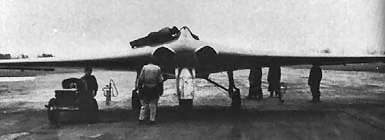

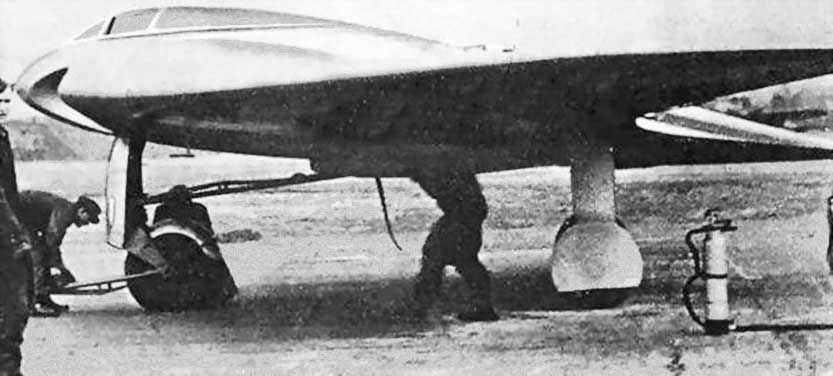
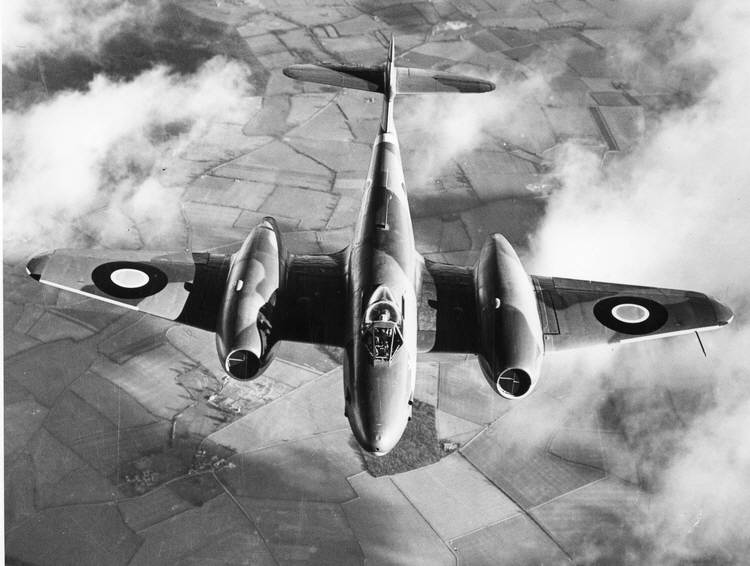
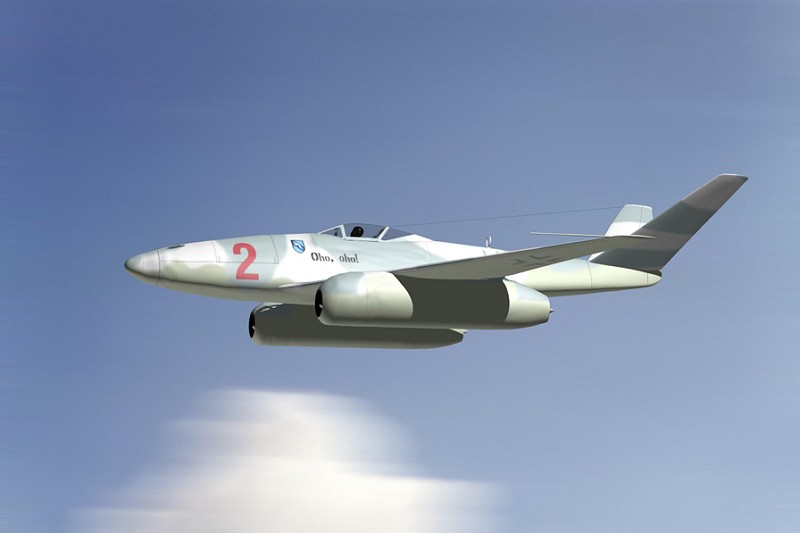
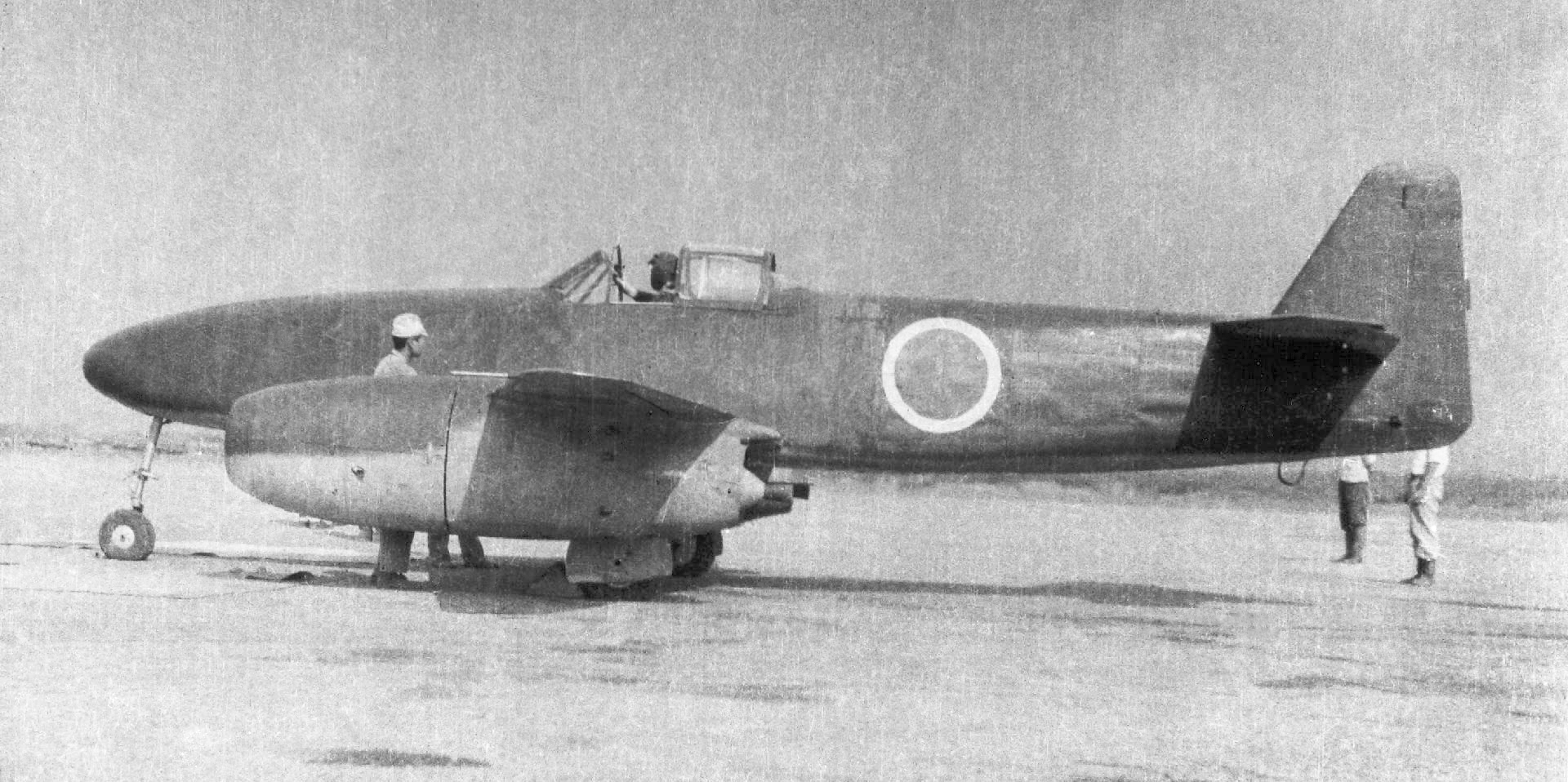





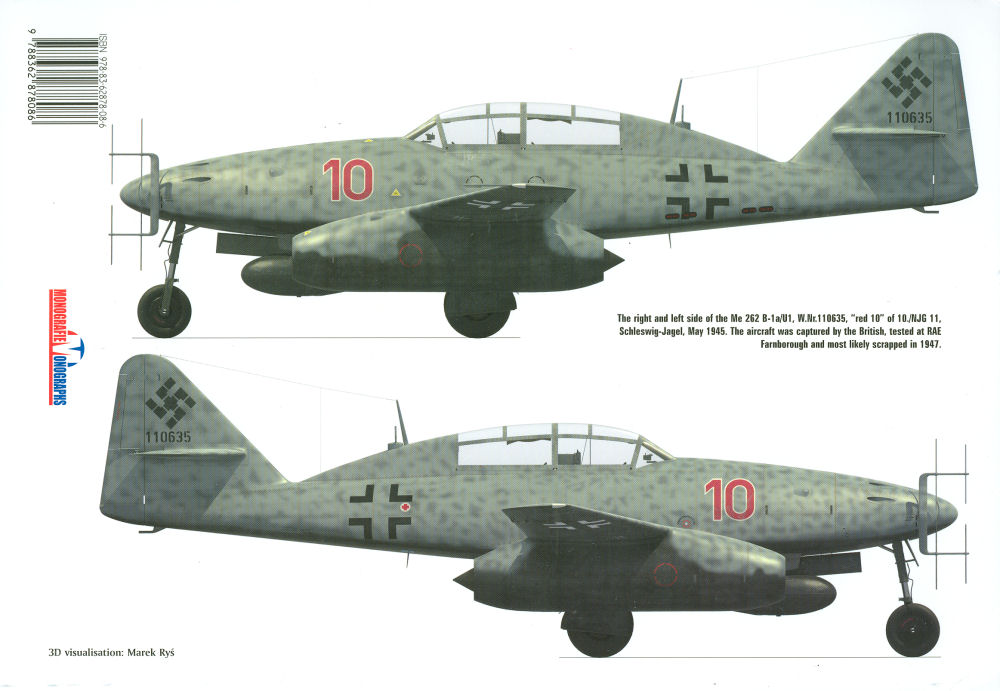

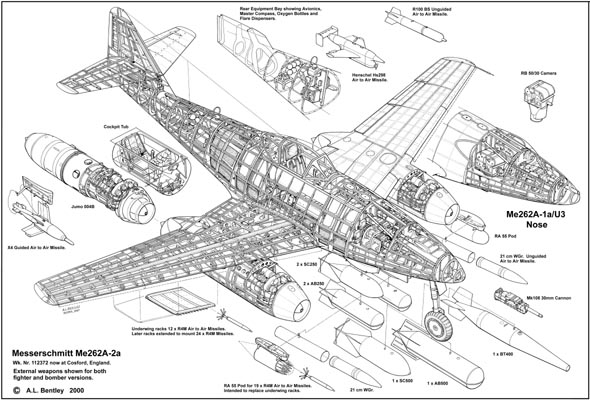


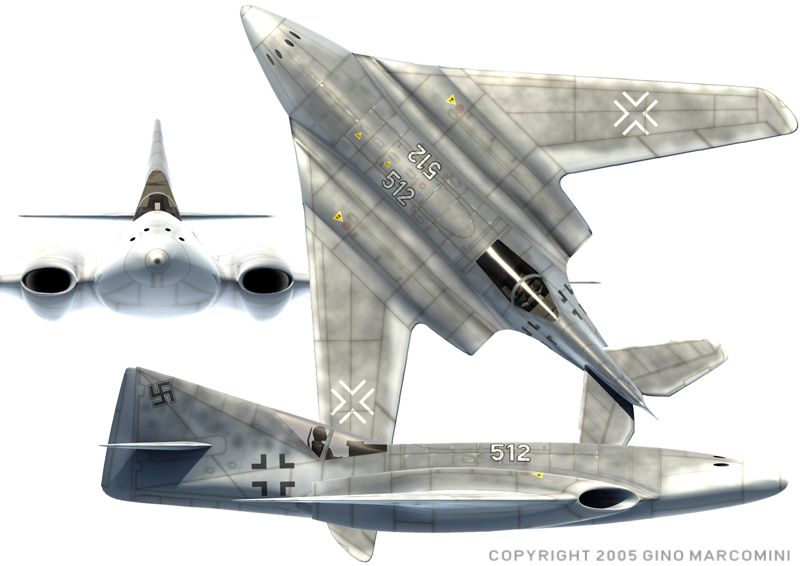

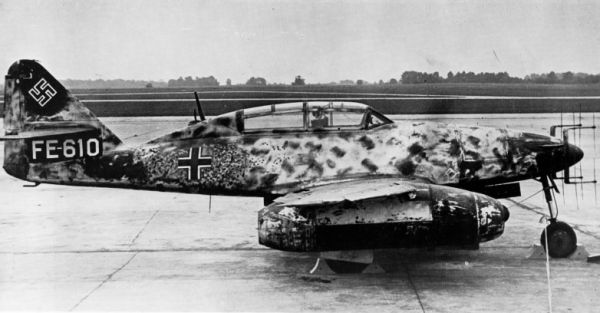

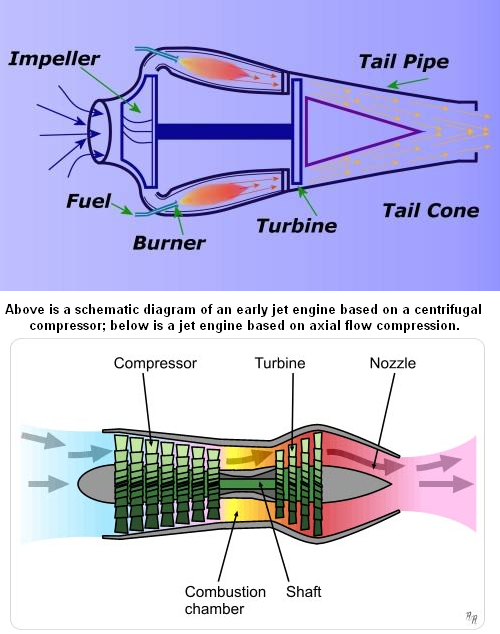

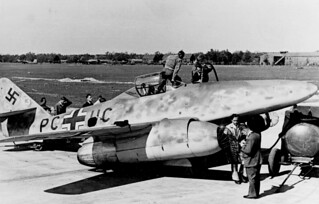





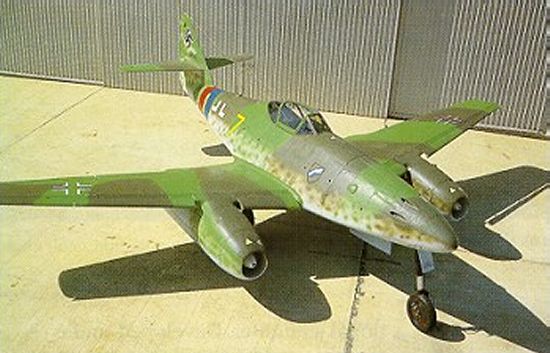


Messerschmitt Me 262
From Wikipedia, the free encyclopedia
| Me 262 Schwalbe | |
|---|---|
 |
|
| Messerschmitt Me 262A | |
| Role | Fighter aircraft |
| Manufacturer | Messerschmitt |
| First flight | 18 April 1941 with piston engine 18 July 1942 with jet engines[1] |
| Introduction | April 1944[2][3] |
| Retired | 1945, Germany 1951, Czechoslovakia[4] |
| Primary users | Luftwaffe Czechoslovak Air Force (S-92) |
| Number built | 1,430 |
Me 262 pilots claimed a total of 542 Allied kills,[8] although higher claims are sometimes made.[Notes 1] The Allies countered its potential effectiveness in the air by attacking the aircraft on the ground and during takeoff and landing. Engine reliability problems—from the pioneering nature of its Junkers Jumo 004 axial-flow turbojet engines, the first ones ever placed in mass production—and attacks by Allied forces on fuel supplies during the deteriorating late-war situation also reduced the effectiveness of the aircraft as a fighting force. In the end, the Me 262 had a negligible impact on the course of the war as a result of its late introduction and the consequently small numbers put in operational service.[10]
The Me 262 was often mistaken by observers for the Gloster Meteor, the first Allied jet fighter aircraft, due to similarities in their appearance, leading to numerous friendly fire incidents on both sides.[citation needed] While German use of the aircraft ended with the close of the Second World War, a small number were operated by the Czechoslovak Air Force until 1951. Captured Me 262 were studied and flight tested by the major powers, and ultimately influenced the designs of a number of post-war aircraft such as the North American F-86 Sabre and Boeing B-47 Stratojet.[7] A number of aircraft have survived on static display in museums, and there have also been several privately built flying reproductions.
Contents
Design and development
Origins
Several years before World War II, the Germans foresaw the great potential for aircraft that used the jet engine constructed by Hans Joachim Pabst von Ohain in 1936. After the successful test flights of the world's first jet aircraft—the Heinkel He 178—within a week of the Invasion of Poland to start the war, they adopted the jet engine for an advanced fighter aircraft. As a result, the Me 262 was already under development as Projekt 1065 (P.1065) before the start of World War II. The project originated with an RLM request for a jet aircraft capable of one hour's endurance and a speed of at least 850 km/h (530 mph; 460 kn).[11] Dr Woldemar Voigt headed the design team, with Messerschmitt's chief of development, Robert Lusser, overseeing.[12]Plans were first drawn up in April 1939, and the original design was very different to the aircraft that eventually entered service, with wing root-mounted engines,[12] rather than podded ones, when submitted in June 1939.[12] The progression of the original design was delayed greatly by technical issues involving the new jet engine. Because the engines were slow to arrive, Messerschmitt moved the engines from the wing roots to underwing pods, allowing them to be changed more readily if needed; this would turn out to be important, both for availability and maintenance.[13] Since the BMW 003 jets proved heavier than anticipated, the wing was swept slightly, by 18.5°, to accommodate a change in the center of gravity.[13] Funding for the jet engine program was also initially lacking as many high-ranking officials thought the war could easily be won with conventional aircraft.[14] Among those were Hermann Göring, head of the Luftwaffe, who cut the engine development program to just 35 engineers in February 1940 (the month before the first wooden mock-up was completed);[12] Willy Messerschmitt, who desired to maintain mass production of the piston-powered Bf 109 and the projected Me 209; and Major General Adolf Galland, who supported Messerschmitt through the early development years, flying the Me 262 himself on 22 April 1943. By that time, problems with engine development had slowed production of the aircraft considerably. One particularly acute problem arose with the lack of an alloy with a melting point high enough to endure the high temperatures involved, a problem that by the end of the war had not been adequately resolved.[14] The aircraft made its first successful flight entirely on jet power on 18 July 1942, powered by a pair of Jumo 004 engines, after a November 1941 flight (with BMW 003s) ended in a double flameout.[15]
In mid-1943, Adolf Hitler envisioned the Me 262 as a ground-attack/bomber aircraft rather than a defensive interceptor. The configuration of a high-speed, light-payload Schnellbomber ("fast bomber") was intended to penetrate enemy airspace during the expected Allied invasion of France. His edict resulted in the development of (and concentration on) the Sturmvogel variant. It is debatable to what extent Hitler's interference extended the delay in bringing the Schwalbe into operation;[20][21] it appears engine vibration issues were at least as costly, if not moreso.[15] Albert Speer, then Minister of Armaments and War Production, claimed in his memoirs that Hitler originally had blocked mass production of the Me 262 before agreeing in early 1944. He rejected arguments that the aircraft would be more effective as a fighter against the Allied bombers that were destroying large parts of Germany, and wanted it as a bomber for revenge attacks. According to Speer, Hitler felt its superior speed compared to other fighters of the era meant it could not be attacked, and so preferred it for high altitude straight flying.[22]
Although the Me 262 is often referred to as a "swept wing" design, the production Me 262 had a leading edge sweep of only 18.5°, too slight to achieve any significant advantage in increasing the critical Mach number.[23] Sweep was added after the initial design of the aircraft, when the engines proved heavier than originally expected, primarily to position the center of lift properly relative to the center of mass. (The original 35° sweep, proposed by Adolph Busemann, was not adopted.)[24] On 1 March 1940, instead of moving the wing backward on its mount, the outer wing was repositioned slightly aft; the trailing edge of the midsection of the wing remained unswept.[25] Based on data from the AVA Göttingen and wind tunnel results, the middle section's leading edge was later swept to the same angle as the outer panels, from the "V6" sixth prototype onwards throughout volume production.[26]
Test flights
The first test flights began on 18 April 1941, with the Me 262 V1 example, bearing its Stammkennzeichen radio code letters of PC+UA, but since its intended BMW 003 turbojets were not ready for fitting, a conventional Junkers Jumo 210 engine was mounted in the V1 prototype's nose, driving a propeller, to test the Me 262 V1 airframe. When the BMW 003 engines were installed, the Jumo was retained for safety, which proved wise as both 003s failed during the first flight and the pilot had to land using the nose-mounted engine alone.[1] The V1 through V4 prototype airframes all possessed what would become an uncharacteristic feature for most later jet aircraft designs, a fully retracting conventional gear setup with a retracting tailwheel — indeed, the very first prospective German "jet fighter" airframe design ever flown, the Heinkel He 280, used a retractable tricycle landing gear from its beginnings, and flying on jet power alone as early as the end of March 1941.
On the second attempt, Wendel solved the problem by tapping the aircraft's brakes at takeoff speed, lifting the horizontal tail out of the wing's turbulence.[29] The aforementioned initial four prototypes (V1-V4) were built with the conventional gear configuration. Changing to a tricycle arrangement — a permanently fixed undercarriage on the fifth prototype (V5), with the definitive fully retractable nosewheel gear on the V6 (with Stammkennzeichen code VI+AA) and subsequent aircraft corrected this problem.[Notes 2]
Test flights continued over the next year, but engine problems continued to plague the project, the Jumo 004 being only marginally more reliable than the BMW 003. Airframe modifications were complete by 1942 but, hampered by the lack of engines, serial production did not begin until 1944, and deliveries were low, with 28 Me 262s in June, 59 in July, but only 20 in August.[7] This delay in engine availability was in part due to the shortage of strategic materials, especially metals and alloys able to handle the extreme temperatures produced by the jet engine.[citation needed]
Even when the engines were completed, they had an expected operational lifetime of approximately 50 continuous flight hours; most 004s lasted just 12 hours, even with adequate maintenance. A pilot familiar with the Me 262 and its engines could expect approximately 20–25 hours of life from the 004s. Changing a 004 engine was intended to require three hours, but this typically took eight to nine due to poorly made parts and inadequate training of ground crews.[citation needed] With one engine out, the Me 262 still flew well, with speeds of 450–500 km/h (280–310 mph; 240–270 kn), but pilots were warned never to fly slower than 300 km/h (190 mph; 160 kn) on one engine, as the asymmetrical thrust would cause serious handling problems.[citation needed]
Due to the high speed jet stream, turbojet engines develop much less thrust at low speed than propeller powered aircraft, resulting in poor low-speed acceleration. This was particularly noticeable in the Me 262, since early jet engines had relatively low power and responded slowly to throttle changes. The introduction of a primitive autothrottle late in the war helped only slightly.[citation needed] Conversely, the superior power of jet engines at higher speeds meant the Me 262 enjoyed a much greater rate of climb. Used tactically, this gave the jet fighter an even larger speed advantage in climb than in level flight at top speed.[citation needed]
Operationally, carrying 2,000 l (440 imp gal; 530 US gal) of fuel in two 900 l (200 imp gal; 240 US gal) tanks, one each fore and aft the cockpit, and a 200 l (44 imp gal; 53 US gal) tank beneath,[Notes 3] the Me 262 would have a total flight endurance of 60 to 90 minutes. Fuel was usually brown coal-derived J2, with the option of diesel oil or a mixture of oil and high octane B4 aviation petrol.[31] Fuel consumption was double the rate of typical twin-engine fighter aircraft of the era, which led to the installation of a low-fuel warning indicator in the cockpit that notified pilots when remaining fuel fell below 250 l (55 imp gal; 66 US gal).[31]
Unit cost for an Me 262 airframe, less engines, armament, and electronics, was RM87,400.[32][Notes 4] To build one airframe took around 6,400 man-hours.[32]
Operational history
Introduction
On 19 April 1944, Erprobungskommando 262 was formed at Lechfeld just south of Augsburg, as a test unit (Jäger Erprobungskommando Thierfelder, commanded by Hauptmann Werner Thierfelder)[3][34] to introduce the 262 into service and train a corps of pilots to fly it. On 26 July 1944, Leutnant Alfred Schreiber with the 262 A-1a W.Nr. 130 017 damaged a Mosquito reconnaissance aircraft of No. 540 Squadron RAF PR Squadron, which was allegedly lost in a crash upon landing at an air base in Italy.[35] Other sources state the aircraft was damaged during evasive manoeuvres and escaped.[36]It was the first victory for a turbojet fighter aircraft in aviation history.[37] Major Walter Nowotny was assigned as commander after the death of Thierfelder in July 1944, and the unit redesignated Kommando Nowotny. Essentially a trials and development unit, it holds the distinction of having mounted the world's first jet fighter operations. Trials continued slowly, with initial operational missions against the Allies in August 1944 allegedly downing 19 Allied aircraft for six Me 262s lost, although these claims have never been verified by cross-checking with USAAF records. The RAF Museum holds no intelligence reports of RAF aircraft engaging in combat with Me 262s in August, although there is a report of an unarmed encounter between an Me 262 and a Mosquito.[38]
Despite orders to stay grounded, Nowotny chose to fly a mission against an enemy bomber formation flying some 30,000 feet above, on 8 November 1944. He claimed two P-51Ds destroyed before suffering engine failure at high altitude.[39] Then, while diving and trying desperately to restart his engines, he was attacked by other Mustangs, and forced to bail out. Historians Morgan and Weal proposed Nowotny's victor was P-51D pilot Lt. Robert W. Stevens of the 364th Fighter Group.[40] The exact circumstances surrounding the death of Walter Nowotny remain uncertain to this day. It is also possible he was hit by "friendly" flak.[40][41] The Kommando was then withdrawn for further training and a revision of combat tactics to optimise the 262's strengths.[citation needed]
During March, Me 262 fighter units were able, for the first time, to mount large-scale attacks on Allied bomber formations. On 18 March 1945, 37 Me 262s of JG 7 intercepted a force of 1,221 bombers and 632 escorting fighters. They shot down 12 bombers and one fighter for the loss of three Me 262s. Although a 4:1 ratio was exactly what the Luftwaffe would have needed to make an impact on the war, the absolute scale of their success was minor, as it represented only one per cent of the attacking force. In 1943 and early 1944, regardless of the presence of the small numbers of Me 262s, the USAAF was able to keep up offensive operations at loss ratios of roughly 5%.[citation needed]
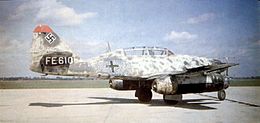
Despite its deficiencies, the Me 262 clearly signaled the beginning of the end of piston-engined aircraft as effective fighting machines. Once airborne, it could accelerate to speeds over 850 km/h (530 mph), about 150 km/h (93 mph) faster than any Allied fighter operational in the European Theater of Operations.[citation needed]
The Me 262's top ace[Notes 5] was probably Hauptmann Franz Schall with 17 kills, which included six four-engine bombers and 10 P-51 Mustang fighters, although night fighter ace Oberleutnant Kurt Welter claimed 25 Mosquitos and two four-engine bombers shot down by night and two further Mosquitos by day flying the Me 262. Most of Welter's claimed night kills were achieved in standard radar-less aircraft, even though Welter had tested a prototype Me 262 fitted with FuG 218 Neptun radar. Another candidate for top ace on the aircraft was Oberstleutnant Heinrich Bär, who claimed 16 enemy aircraft while flying the Me 262.[citation needed]
Anti-bomber tactics

Since the 30mm MK 108 cannon's short barrels and low muzzle velocity of 540 m/s (1,800 ft/s) rendered it inaccurate beyond 600 m (660 yd), coupled with the jet's velocity, which required breaking off at 200 m (220 yd) to avoid colliding with the target, Me 262 pilots normally commenced firing at 500 m (550 yd).[44] Allied bomber gunners found their electric gun turrets had problems tracking the jets. Target acquisition was difficult because the jets closed into firing range quickly and remained in firing position only briefly, using their standard attack profile, which proved more effective.[citation needed]
Eventually, German pilots developed new combat tactics to counter Allied bombers' defenses. Me 262s, equipped with R4M rockets, approached from the side of a bomber formation, where their silhouettes were widest, and while still out of range of the bombers' machine guns, fired a salvo of rockets with strongly brisant Hexogen-filled warheads, exactly the same explosive in the shells fired by the Me 262A's quartet of MK 108 cannon. One or two of these rockets could down even the famously rugged B-17 Flying Fortress,[45] from the "metal-shattering" brisant effect of the R4M rockets' explosive warheads, weighing only some 520 grams (17.6 ounces) per projectile out of a total launch weight of 4 kg (8.8 pounds) apiece.
Though this tactic was effective, it came too late to have a real effect on the war, and only small numbers of Me 262s were equipped with the rocket packs.[46] Most of those so equipped were Me 262A-1as, members of Jagdgeschwader 7.[47] This method of attacking bombers became the standard, and mass deployment of Ruhrstahl X-4 guided missiles was cancelled. Some nicknamed this tactic the Luftwaffe's Wolf Pack, as the fighters often made runs in groups of two or three, fired their rockets, then returned to base. On 1 September 1944, USAAF General Carl Spaatz expressed the fear that if greater numbers of German jets appeared, they could inflict losses heavy enough to force cancellation of the Allied bombing offensive by daylight.[citation needed]
Counter-jet tactics
The Me 262 was difficult for its opponents to counter because its high speed and rate of climb made it extremely hard to intercept. As with all other early jets, the Me 262's engines did not provide a lot of thrust at low air speeds (a key criterion for good turn performance at low speeds), and throttle response was slow. Another disadvantage all early jet engines shared was a relatively high risk of flameout if the pilot used the throttle too aggressively (as is common in a dogfight).[citation needed] Pilots were instructed to operate the throttle gently and avoid quick changes. German engineers introduced an automatic throttle regulator later in the war but it only partly alleviated the problem. On the plus side, thrust at high speed was much greater than on propeller-driven aircraft.[citation needed]The plane had, by contemporary standards, quite a high wing loading (294.0 kg/m2, 60.2 lbs/ft2) and its turn radius at low speeds was therefore correspondingly wide. This, coupled with the low thrust at slow speeds and high chance of a flameout if the throttle was worked too aggressively, resulted in Me 262 pilots being told to avoid low speed dogfights with the Allied piston-engine fighters.[citation needed] The high speed of the Me 262 also presented problems when engaging enemy aircraft, the high-speed convergence allowing Me 262 pilots little time to line up their targets or acquire the appropriate amount of deflection. This problem faces any aircraft that approaches another from behind at much higher speed, as the slower aircraft in front can always pull a tighter turn, forcing the faster aircraft to overshoot. The Me 262 faced this problem frequently as its cruising speed alone was up to 200 km/h (120 mph) faster than that of any piston-engine fighter of the period.[citation needed]
"I passed one that looked as if it was hanging motionless in the air
(I am too fast!). The one above me went into a steep right-hand turn,
his pale blue underside standing out against the purple sky. Another
banked right in front of the Me's nose. Violent jolt as I flew through
his airscrew eddies. Maybe a wing's length away. That one in the gentle
left-hand curve! Swing her round. I was coming from underneath, eye
glued to the sight (pull her tighter!). A throbbing in the wings as my
cannon pounded briefly. Missed him. Way behind his tail. It was
exasperating. I would never be able to shoot one down like this. They
were like a sack of fleas. A prick of doubt: is this really such a good
fighter? Could one in fact, successfully attack a group of erratically
banking fighters with the Me 262?"
Pilots soon learned that the Me 262 was quite maneuverable, despite its high wing loading and lack of low-speed thrust, especially if attention was drawn to its effective maneuvering speeds. The controls were light and effective right up to the maximum permissible speed and perfectly harmonized. The inclusion of full span automatic leading edge slats,[Notes 6] something of a "tradition" on Messerschmitt fighters dating back to the original Bf 109's outer wing slots of a similar type, helped increase the overall lift produced by the wing by as much as 35% in tight turns or at low speeds, greatly improving the aircraft's turn performance as well as its landing and take off characteristics.[51] And as many pilots soon found out, the Me 262's clean design also meant that it, like all jets, held its speed in tight turns much better than conventional propeller-driven fighters, which was a great potential advantage in a dogfight as it meant better energy retention in maneuvers.[52] Luftwaffe test pilot and flight instructor Hans Fey stated, "The 262 will turn much better at high than at slow speeds and, due to its clean design, will keep its speed in tight turns much longer than conventional type aircraft."[53]

Allied pilots soon found that the only reliable way to destroy the jets, as with the even faster Me 163 Komet rocket fighters, was to attack them on the ground or during takeoff or landing. Luftwaffe airfields identified as jet bases were frequently bombed by medium bombers, and Allied fighters patrolled over the fields to attack jets trying to land. The Luftwaffe countered by installing extensive flak alleys of anti-aircraft guns along the approach lines to protect the Me 262s from the ground—and by providing top cover during the jets' takeoff and landing with the most advanced Luftwaffe single-engined fighters, the Focke-Wulf Fw 190D and (just becoming available in 1945) Focke-Wulf Ta 152H.[55] Nevertheless, in March–April 1945, Allied fighter patrol patterns over Me 262 airfields resulted in numerous jet losses.[citation needed]
The British Hawker Tempest scored a number of kills against the new German jets, including the Messerschmitt Me 262. Hubert Lange, a Me 262 pilot, said: "the Messerschmitt Me 262's most dangerous opponent was the British Hawker Tempest — extremely fast at low altitudes, highly manoeuvrable and heavily armed."[56] Some were destroyed with a tactic known to the Tempest 135 Wing as the "Rat Scramble":[57] Tempests on immediate alert took off when an Me 262 was reported airborne. They did not intercept the jet, but instead flew towards the Me 262 and Ar 234 base at Rheine-Hopsten.[58][Notes 8] The aim was to attack jets on their landing approach, when they were at their most vulnerable, travelling slowly, with flaps down and incapable of rapid acceleration. The German response was the construction of a "flak lane" of over 150 quadruple 20 mm (.79 in) autocannon at Rheine-Hopsten to protect the approaches.[59][Notes 9] After seven Tempests were lost to flak at Rheine-Hopsten in a single week, the "Rat Scramble" was discontinued.[60]
High-speed research
Interest in high-speed flight, which led him to initiate work on swept wings starting in 1940, is evident from the advanced developments Messerschmitt had on his drawing board in 1944. While the Me 262 V9 Hochgeschwindigkeit I (HG I) actually flight tested in 1944 had only small changes compared to combat aircraft, most notably a low-profile canopy — tried as the Rennkabine (literally "racing cabin") on the ninth Me 262 prototype for a short time) to reduce drag, the HG II and HG III designs were far more radical. The projected HG II combined the low-drag canopy with a 35° wing sweep and a butterfly tail. The HG III had a conventional tail, but a 45° wing sweep and turbines embedded in the wing roots.[63]
Messerschmitt also conducted a series of flight tests with the series production Me 262. In dive tests, they determined that the Me 262 went out of control in a dive at Mach 0.86, and that higher Mach numbers would cause a nose-down trim that the pilot could not counter. The resulting steepening of the dive would lead to even higher speeds and the airframe would disintegrate from excessive negative g loads.[citation needed]
The HG series of Me 262 derivatives was believed capable of reaching transonic Mach numbers in level flight[citation needed], with the top speed of the HG III being projected as Mach 0.96 at 6,000 m (20,000 ft) altitude. Despite the necessity to gain experience in high-speed flight for the HG II and III designs, Messerschmitt made no attempt to exceed the Mach 0.86 limit for the Me 262. After the war, the Royal Aircraft Establishment, at that time one of the leading institutions in high-speed research, re-tested the Me 262 to help with British attempts at exceeding Mach 1. The RAE achieved speeds of up to Mach 0.84 and confirmed the results from the Messerschmitt dive tests. The Soviets ran similar tests.
After Willy Messerschmitt's death in 1978, the former Me 262 pilot Hans Guido Mutke claimed to have exceed Mach 1, on 9 April 1945 in a Me 262 in a "straight-down" 90° dive. This claim is disputed because it is only based on Mutke's memory of the incident, which recalls effects other Me 262 pilots observed below the speed of sound at high indicated airspeed, but with no altitude reading required to determine the actual speed. Furthermore, the pitot tube used to measure airspeed in aircraft can give falsely elevated readings as the pressure builds up inside the tube at high speeds. Finally, the Me 262 wing had only a slight sweep, incorporated for trim (center of gravity) reasons and likely would have suffered structural failure due to divergence at high transonic speeds. One airframe — the aforementioned Me 262 V9, Werknummer 130 004, with Stammkennzeichen of VI+AD,[64] was prepared as the HG I test airframe with the low-profile Rennkabine racing canopy and may have achieved an unofficial record speed for a turbojet-powered aircraft of 975 km/h (606 mph), altitude unspecified.[65]
Production
About 1,400 Me 262s were produced, but a maximum of 200 were operational at the same time. According to sources they destroyed from 300 to 450 enemy planes, with the Allies destroying about 100 Me 262s in the air.[55] While Germany was bombed intensively, production of the Me 262 was dispersed into low-profile production facilities, sometimes little more than clearings in the forests of Germany and occupied countries. Through the end of February to the end of March 1945, approximately 60 Me 262s were destroyed in attacks on Obertraubling and 30 at Leipheim;[66] the Neuberg jet plant itself was bombed on 19 March 1945.[67]Large, heavily protected underground factories were constructed to take up production of the Me 262, safe from bomb attacks, but the war ended before they could be completed. Wings were produced in Germany's oldest motorway tunnel at Engelberg to the west of Stuttgart. At B8 Bergkristall-Esche II at St. Georgen/Gusen, Austria, forced laborers of Concentration Camp Gusen II produced fully equipped fuselages for the Me 262 at a monthly rate of 450 units on large assembly lines from early 1945.[68]
Postwar history
During testing, the Me 262 was found to have advantages over the early models of the Gloster Meteor. It was faster, had better cockpit visibility to the sides and rear (mostly due to the canopy frame and the discoloration caused by the plastics used in the Meteor's construction), and was a superior gun platform, as the early Meteors had a tendency to snake at high speed and exhibited "weak" aileron response.[69] The Me 262 did have a shorter combat range than the Meteor.
The USAAF compared the P-80 Shooting Star and Me 262 concluding, "Despite a difference in gross weight of nearly 2,000 lb (900 kg), the Me 262 was superior to the P-80 in acceleration, speed and approximately the same in climb performance. The Me 262 apparently has a higher critical Mach number, from a drag standpoint, than any current Army Air Force fighter."[70]
The Army Air Force also tested an example of the Me 262A-1a/U3 (US flight evaluation serial FE-4012), an unarmed photo reconnaissance version, which was fitted with a fighter nose and given an overall smooth finish. It was used for performance comparisons against the P-80. During testing between May and August 1946, the aircraft completed eight flights, lasting four hours and 40 minutes. Testing was discontinued after four engine changes were required during the course of the tests, culminating in two single-engine landings.[71] These aircraft were extensively studied, aiding development of early U.S. and Soviet jet fighters. The F-86, designed by engineer Edgar Schmued, used a slat design based on the Me 262.[72]
The Czechoslovak aircraft industry continued to produce single-seat (Avia S-92) and two-seat (Avia CS-92) variants of the Me 262 after World War II. From August 1946, a total of nine S-92s and three two-seater CS-92s were completed and test flown. They were introduced in 1947 and in 1950 were supplied to the 5th Fighter Squadron, becoming the first jet fighters to serve in the Czechoslovak Air Force. These were kept flying until 1951,[4] when they were replaced in service by more advanced jet fighters of Soviet origin. Both versions are on display at the Prague Aviation museum in Kbely.
Flyable reproductions
In January 2003, the American Me 262 Project, based in Everett, Washington, completed flight testing to allow the delivery of near-exact reproductions of several versions of the Me 262 including at least two B-1c two-seater variants, one A-1c single seater and two "convertibles" that could be switched between the A-1c and B-1c configurations. All are powered by General Electric J85 engines and feature additional safety features, such as upgraded brakes and strengthened landing gear. The "c" suffix refers to the new J85 powerplant and has been informally assigned with the approval of the Messerschmitt Foundation in Germany[73] (the Werk Number of the reproductions picked up where the last wartime produced Me 262 left off – a continuous airframe serial number run with a 50-year production break).Flight testing of the first newly manufactured Me 262 A-1c (single-seat) variant (Werk Number 501244) was completed in August 2005. The first of these machines (Werk Number 501241) went to a private owner in the southwestern United States, while the second (Werk Number 501244) was delivered to the Messerschmitt Foundation at Manching, Germany. This aircraft conducted a private test flight in late April 2006, and made its public debut in May at the ILA 2006. The new Me 262 flew during the public flight demonstrations.[74] Me 262 Werk Number 501241 was delivered to the Collings Foundation as White 1 of JG 7; this aircraft offered ride-along flights starting in 2008.[75] The third replica, a non-flyable Me 262 A-1c, was delivered to the Evergreen Aviation & Space Museum in May 2010.[76]
Variants
Note:- U = Umrüst-Bausätz - conversion kit installed at factory level, denoted as a suffix in the form /Un.[77]- Me 262 A-0
- Pre-production aircraft fitted with two Jumo 004B turbojet engines, 23 built.
- Me 262 A-1a "Schwalbe"
- Primary production version, usable as both fighter (interceptor) and fighter-bomber.
- Me 262 A-1a/U1
- Single prototype with a total of six nose mounted guns, two 20 mm (0.787 in) MG 151/20 cannon, two 30 mm (1.181 in) MK 103 cannon, and two 30 mm (1.181 in) MK 108 cannon.
- Me 262 A-1a/U2
- Single prototype with FuG 220 Lichtenstein SN-2 90 MHz radar transceiver and Hirschgeweih (stag's antlers) antenna array, for trials as a night-fighter.
- Me 262 A-1a/U3
- Reconnaissance version modified in small numbers, with Rb 20/30[78] cameras mounted in the nose or alternatively one Rb 20/20[78] and one Rb 75/30[78] (Rb - Reihenbildmesskammer - series-picture, topographic camera). Some retained one 30 mm (1.181 in) MK 108 cannon, but most were unarmed.
- Me 262 A-1a/U4
- Bomber destroyer version, two prototypes with an adapted 50 mm (1.969 in) MK 214 (intended armament) or BK 5 (test ordnance only) anti-tank gun in the nose.
- Me 262 A-1a/U5
- Heavy jet fighter with six 30 mm (1.181 in) MK 108 cannon in the nose
- Me 262 A-1b
- Trio of A-1a evaluation versions, starting with Werknummer 170 078, re-engined with two BMW 003 turbojets in place of the Jumo 004s, maximum speed 800 km/h (500 mph; 430 kn).[79]
- Me 262 A-2a "Sturmvogel"
- Definitive bomber version retaining only the two lower 30 mm (1.181 in) MK 108 cannon.
- Me 262 A-2a/U1
- Single prototype with advanced bombsight.
- Me 262 A-2a/U2
- Two prototypes with glazed nose for accommodating a bombardier.
- Me 262 A-3a
- Proposed ground-attack version.
- Me 262 A-4a
- Reconnaissance version.
- Me 262 A-5a
- Definitive reconnaissance version used in small numbers at end of the war.
- Me 262 B-1a
- Two-seat trainer.
- Me 262 B-1a/U1
- Me 262 B-1a trainers converted into provisional night fighters, FuG 218 Neptun radar, with Hirschgeweih (eng:antler) eight-dipole antenna array.[80]
- Me 262 B-2
- Proposed night fighter version with stretched fuselage.
- Me 262 C-1a
- Single prototype [made from Me 262A Werknummer 130 186] of rocket-boosted interceptor (Heimatschützer I) with Walter HWK 109-509 liquid-fuelled rocket in the tail, first flown with combined jet/rocket power on 27 February 1945.[81]
- Me 262 C-2b
- Single prototype [made from Me 262A Werknummer 170 074] of rocket-boosted interceptor (Heimatschützer II) with two BMW 003R "combined" powerplants (BMW 003 turbojet, with a single 9.8 kN (2,200 lbf) thrust BMW 109-718 liquid-fuelled rocket engine mounted atop the rear of each jet exhaust) for boosted thrust, only flown once with combined jet/rocket power on 26 March 1945.[82]
- Me 262 C-3
- Heimatschützer III - proposed version with Jumo 004 turbojet engines replaced with Walter HWK RII-211 Liquid-fuelled rocket engines.[83]
- Me 262 C-3a
- Heimatschützer IV - a rocket-boosted interceptor with a Walter HWK 109-509S-2 rocket motor housed in a permanent belly pack. Prototypes and initial production aircraft were captured before completion.[84]
- Me 262 D-1
- Proposed variant to carry Jagdfaust mortars.
- Me 262 E-1
- Proposed variant based on A-1a/U4 with a 55 mm (2.165 in) MK 114 cannon.
- Me 262 E-2
- Proposed rocket-armed variant carrying up to 48 × R4M rockets.
- Me 262 S
- Zero-series model for Me 262 A-1a
- Me 262 W-1
- Provisional designation for Me 262 with 2x 2.7 kN (610 lbf) Argus As 014 pulse jet engines
- Me 262 W-3
- Provisional designation for Me 262 with 2x 4.90 kN (1,102 lbf) Argus As 044 pulse jet engines
- Me 262 Lorin
- Provisional designation for Me 262 with 2x Lorin ramjet booster engines in "over-wing" mounts, one above each of the Jumo turbojet nacelles.
Rüstsätze (field modification kits)
Rüstsatze may be applied to various sub-types of their respective aircraft type, denoted as a suffix in the form /Rn. Data from:'Messerschmitt Me 262A Schwalbe[77][85]- /R1
- Underfuselage pylon for 500 l (110.0 imp gal; 132.1 US gal) external fuel tank.
- /R2
- Ratog installation for two Rheinmetall 109-502 solid rocket engines.
- /R3
- BMW 003R rocket boosted turbojet installation.
- /R4
- Installation of the FuG 350 Zc Naxos radar warning receiver / detector.
- /R5
- The standard 4x 30 mm (1.181 in) MK 108 cannon installation
- /R6
- Jabo (JagdBomber) equipment, such as bombsights and bomb racks.
- /R7
- Underwing installation of 12x R4M rockets carried on wooden racks'
- /R8
- R110BS Air to air rocket installation
- /R9
- Ruhrstahl Ru 344 X-4 air-to-air missile installation.
Postwar variants
- Avia S-92[86]
- Czech-built Me 262 A-1a (fighter)[87]
- Avia CS-92
- Czech-built Me 262 B-1a (fighter trainer, two seats)
Reproductions
These reproductions are constructed by Legend Flyers (later Me 262 Project) of Everett, Washington.[88] The Jumo 004 engines of the original are replaced by more reliable General Electric CJ610 engines. The Jumo 004 was hampered by poor workmanship and a lack of high-temperature super alloys.[89] The first Me 262 reproduction (a two-seater) took off for the first time in December 2002 and the second one in August 2005. This one was delivered to the Messerschmitt Foundation and was presented at the ILA airshow in 2006.[90]- A-1c
- American privately built, based on A-1a configuration.
- B-1c
- American privately built, based on B-1a configuration.
- A/B-1c
- American privately built, convertible between A-1c and B-1c configuration.
Operators
 Luftwaffe
Luftwaffe
 Russian Liberation Army Air Force (one or two Me 262 assigned)[91] (Vlasov's Air Force mentions two Me 262 machines assigned.)[92]
Russian Liberation Army Air Force (one or two Me 262 assigned)[91] (Vlasov's Air Force mentions two Me 262 machines assigned.)[92]
 Czechoslovak Air Force (postwar, nine S-92 and three CS-92)
Czechoslovak Air Force (postwar, nine S-92 and three CS-92)
Survivors
- Me 262A, W.Nr.500071 White 3, III./JG 7
- Deutsches Museum,[93] Munich, Germany. This aircraft, flown by Hans Guido Mutke while a pilot of 9. Staffel/JG 7, was confiscated by Swiss authorities on 25 April 1945 after Mutke made an emergency landing in Switzerland due to lack of fuel (80 litres were remaining, 35 litres were usually burnt in one minute).
- Me 262 A-1a
- Reconstructed from parts of crashed and incomplete Me 262s. Luftwaffenmuseum der Bundeswehr, Germany.
- Me 262 A-1a W.Nr.501232 Yellow 5, 3./KG(J)6
- National Museum of the United States Air Force, Wright-Patterson Air Force Base, Dayton, Ohio, USA.
- Me 262 A-1a/U3 W.Nr.500453
- Flying Heritage Collection, Everett, Washington, USA, currently in US undergoing restoration to flying condition. It is intended to fly using its original Jumo 004 engines.[94] The aircraft was bought from The Planes Of Fame, Chino, California.
- Me 262 A-1a W.Nr.500491 Yellow 7, II./JG 7
- National Air and Space Museum, Smithsonian Institution, Washington, DC, USA.
- Me 262 A-2a W.Nr.112372
- RAF Museum Hendon, London, United Kingdom.
- Me 262 A-2a W.Nr.500200 Black X 9K+XK, 2 Staffel./KG 51
- Australian War Memorial, Canberra, Australia. Built at Regensburg in March 1945, same batch from which the Deutsches Museum White 3 was built. Flown by Fahnenjunker Oberfeldwebel Fröhlich and surrendered at Fassberg. She remains the only Me 262 left in existence wearing her original (albeit worn, as seen in the picture) colours. Her markings show both the Unit signatures along with the Air Ministry colours applied at Farnborough, where she was allocated reference Air Min 81. Restoration was completed in 1985 and aircraft was put up on display.[95]
- Me 262 B-1a/U1, W.Nr.110305 Red 8
- South African National Museum of Military History, Johannesburg, South Africa.
- Me 262 B-1a, W.Nr.110639 White 35
- National Museum of Naval Aviation, Pensacola, Florida (previously at NAS/JRB Willow Grove, Willow Grove, Pennsylvania, USA)
- Avia S-92
- Prague Aviation Museum, Kbely, Prague, Czech Republic.
- Avia CS-92
- Prague Aviation Museum, Kbely, Prague, Czech Republic.
Specifications (Messerschmitt Me 262 A-1a)
General characteristics- Crew: 1
- Length: 10.60 m (34 ft 9 in)
- Wingspan: 12.60 m (41 ft 6 in)
- Height: 3.50 m (11 ft 6 in)
- Wing area: 21.7 m² (234 ft²)
- Empty weight: 3,795 kg[97] (8,366 lb)
- Loaded weight: 6,473 kg[97] (14,272 lb)
- Max. takeoff weight: 7,130 kg[97] (15,720 lb)
- Powerplant: 2 × Junkers Jumo 004 B-1 turbojets, 8.8 kN (1,980 lbf) each
- Aspect ratio: 7.32
- Maximum speed: 900 km/h (559 mph)
- Range: 1,050 km (652 mi)
- Service ceiling: 11,450 m (37,565 ft)
- Rate of climb: 1,200 m/min (At max weight of 7,130 kg) (3,900 ft/min)
- Thrust/weight: 0.28
- Guns: 4 × 30 mm MK 108 cannon (A-2a: two cannon)
- Rockets: 24 × 55 mm (2.2 in) R4M rockets
- Bombs: 2 × 250 kg (550 lb) bombs or 2 × 500 kg (1,100 lb) bombs (A-2a variant)
Gloster Meteor
From Wikipedia, the free encyclopedia
| Meteor | |
|---|---|
 |
|
| Operational RAF Meteor F.4 in July 1955 | |
| Role | Fighter |
| Manufacturer | Gloster Aircraft Company |
| First flight | 5 March 1943 |
| Introduction | 27 July 1944 |
| Retired | 1980s (RAF target tugs/Ecuador combat roles) |
| Primary users | Royal Air Force Royal Australian Air Force Belgian Air Force Argentine Air Force |
| Number built | 3,947 |
Several major variants of the Meteor incorporated technological advances during the 1940s and 1950s. Thousands of Meteors were built to fly with the RAF and other air forces and remained in use for several decades. The Meteor saw limited action in the Second World War. Meteors of the Royal Australian Air Force (RAAF) provided a significant contribution in the Korean War. Several other operators such as Argentina, Egypt and Israel flew Meteors in later regional conflicts. Specialised variants of the Meteor were developed for use in photo-reconnaissance and as night fighters.
The Meteor was also used for research and development purposes and to break several aviation records. On 7 November 1945, the first official air speed record by a jet aircraft was set by a Meteor F.3 of 606 miles per hour (975 km/h). In 1946, this record was broken when a Meteor F.4 reached a speed of 616 mph (991 km/h). Other performance-related records were broken in categories including flight time endurance, rate of climb, and speed. On 20 September 1945, a heavily modified Meteor I, powered by two Rolls-Royce Trent turbine engines driving propellers, became the first turboprop aircraft to fly.[1] On 10 February 1954, a specially-adapted Meteor F.8, the "Meteor Prone Pilot", which placed the pilot into a prone position to counteract inertial forces, took its first flight.[2]
In the 1950s, the Meteor became increasingly obsolete as more nations introduced jet fighters, many of these newcomers having adopted a swept wing instead of the Meteor's conventional straight wing; in RAF service, the Meteor was replaced by newer types such as the Hawker Hunter and Gloster Javelin. As of 2013, two Meteors, WL419 and WA638, remain in active service with the Martin-Baker company as ejection seat testbeds. Two further aircraft in the UK remain airworthy, as does another in Australia.
Contents
Development
Origins
See also: Frank Whittle
The development of the turbojet-powered Gloster Meteor was a collaboration between the Gloster Aircraft Company and Sir Frank Whittle's firm, Power Jets
Ltd. Frank Whittle formed Power Jets Ltd in March 1936 to develop his
ideas of jet propulsion, Whittle himself serving as the company's chief
engineer, outside of his duties as an RAF flying officer.[3]
For several years, attracting financial backers and aviation firms
prepared to take on Whittle's radical ideas was difficult; in 1931, Armstrong-Siddeley had evaluated and rejected Whittle's proposal, finding it to be technically sound but at the limits of engineering capability.[4] Securing funding was a persistently worrying issue throughout the early development of the engine.[5] The first Whittle prototype jet engine, the Power Jets WU, began running trials in early 1937; shortly afterwards, both Sir Henry Tizard, chairman of the Aeronautical Research Committee, and the Air Ministry gave the project their support.[6]On 28 April 1939, Whittle made a visit to the premises of the Gloster Aircraft Company, where he met several key figures, such as George Carter, Gloster's chief designer.[7] Carter took a keen interest in Whittle's project, particularly when he saw the operational Power Jets W.1 engine; Carter quickly made several rough proposals of various aircraft designs powered by the engine. Independently, Whittle had also been producing several proposals for a high-altitude jet-powered bomber; following the start of the Second World War and the Battle for France, a greater national emphasis on fighter aircraft arose.[8] Power Jets and Gloster quickly formed a mutual understanding around mid-1939.[9]
In spite of ongoing infighting between Power Jets and several of its stakeholders, the Air Ministry contracted Gloster to manufacture a prototype aircraft powered by one of Whittle's new turbojet engines in late 1939.[10] The single-engined proof-of-concept Gloster E28/39, the first British jet-powered aircraft, conducted its maiden flight on 15 May 1941, flown by Gloster's Chief Test Pilot, Flight Lieutenant Philip "Gerry" Sayer.[11][12] The success of the smaller E.28/39 proved the viability of jet propulsion, and Gloster pressed ahead with designs for a production fighter aircraft.[13] Due to the limited thrust available from early jet engines, it was decided that subsequent production aircraft would be powered by a pair of turbojet engines.[14]
In 1940, for a "military load" of 1,500 lb (680 kg), the RAE had advised that work on an aircraft of 8,500 lb (3,900 kg) all-up weight, with a static thrust of 3,200 lb (14.2 kN) should be started, with an 11,000 lb (4,990 kg) design for the expected more powerful W.2 and axial engine designs. George Carter's calculations based on the RAE work and his own investigations was that a 8,700–9,000 lb (3,900–4,100 kg) aircraft with two or four 20 mm cannon and six 0.303 machine guns would have a top speed of 400-431 mph at sea level and 450-470 mph at 30,000 ft. In January 1941 Gloster were told by Lord Beaverbrook that the twin jet fighter was of "unique importance", and that the company was to stop work on a night-fighter being developed to Specification F.18/40.[15]
Prototypes

On 5 March 1943, the fifth prototype, serial DG206, powered by two de Havilland Halford H.1 engines owing to problems with the intended Power Jets W.2 engines, became the first Meteor to become airborne at RAF Cranwell, piloted by Michael Daunt.[11] On the initial flight, an uncontrollable yawing motion was discovered, which led to a redesigned larger rudder; however, no difficulties had been attributed to the groundbreaking turbojet propulsion.[20] Only two prototypes flew with de Havilland engines because of the low flight endurance they were capable of providing.[21] Before the first prototype aircraft had even undertaken its first flight, an extended order for 100 production-standard aircraft had already been placed by the RAF.[22]
The first Whittle-engined aircraft, DG205/G, flew on 12 June 1943 (later crashing during takeoff on 27 April 1944) and was followed by DG202/G on 24 July. DG202/G was later used for deck handling tests aboard aircraft carrier HMS Pretoria Castle.[23][24] DG203/G made its first flight on 9 November 1943, later becoming a ground instructional model. DG204/G, powered by Metrovick F.2 engines, first flew on 13 November 1943; DG204/G was lost in an accident on 4 January 1944, the cause believed to have been an engine compressor failure due to overspeed.[25]
DG208/G made its debut on 20 January 1944, by which time the majority of design problems had been overcome and a production design had been approved. DG209/G was used as an engine testbed by Rolls-Royce, first flying on 18 April 1944. DG207/G was intended to be the basis for the Meteor F.2 with de Havilland engines, but it did not fly until 24 July 1945, at which time the Meteor 3 was in full production and de Havilland's attention was being redirected to the incoming de Havilland Vampire, thus the F.2 was cancelled.[26][27][28]
Into production
On 12 January 1944, the first Meteor F.1, serial EE210/G, took to the air from Moreton Valence. It was essentially identical to the F9/40 prototypes except for the addition of four nose-mounted 20 mm (.79 in) Hispano Mk V cannons and some changes to the canopy to improve all-round visibility.[29] Due to the F.1's similarity to the prototypes, they were frequently operated in the test program to progress British understanding of jet propulsion, and it took until July 1944 for the aircraft to enter squadron service.[30] EE210/G was later sent to the U.S. for evaluation, where it was first flown at Muroc Army Airfield on 15 April 1944.[31]Originally 300 F.1s were ordered, but the total produced was reduced to 20 aircraft as the follow-on orders had been converted to the more advanced models.[32] Some of the last major refinements to the Meteor's early design were trialed using this first production batch, and what was to become the long-term design of the engine nacelles was introduced upon EE211.[33] EE215 was the first Meteor to be fitted with guns; EE215 was also used in engine reheat trials,[34] and was later converted into the first two-seat Meteor.[35] Due to the radical differences between jet-powered aircraft and those that preceded, a special Tactical Flight or T-Flight unit was established to prepare the Meteor for squadron service, led by Group Captain Hugh Joseph Wilson.[36] The Tactical Flight was formed at Farnborough in May 1944, the first Meteors arriving the following month, upon which both tactical applications and limitations were extensively explored.[37]
On 17 July 1944, the Meteor F.1 was cleared for service use. Shortly afterwards, elements of the Tactical flight and their aircraft were transferred to operational RAF squadrons.[38] The first deliveries to No. 616 Squadron RAF, the first operational squadron to receive the Meteor, began in July 1944.[22] When the F.2 was cancelled, the Meteor F.3 became the immediate successor to the F.1 and alleviated some of the shortcomings of the F.1.[39]
Several Meteor F.3s were converted into navalised Meteors. The adaptations included a strengthened undercarriage and arrester hook. Operational trials of the type took place aboard HMS Implacable. The trials included carrier landings and takeoffs.[40] Performance of these naval prototype Meteors proved to be favorable, including takeoff performance, leading to further trials with a modified Meteor F.4 fitted with folding wings; a 'clipped wing' was also adopted.[41] The Meteor later entered service with the Royal Navy, but only as a land-based trainer, the Meteor T.7, to prepare pilots of the Fleet Air Arm for flying other jet aircraft such as the de Havilland Sea Vampire.[42]
While various marks of Meteor had been introduced by 1948, they had remained very similar to the prototypes of the Meteor; consequently, the performance of the Meteor F.4 was beginning to be eclipsed by new jet designs. Gloster therefore embarked on a redesign programme to produce a new version of the Meteor with better performance.[43] Designated Meteor F.8, this upgraded variant was a potent fighter aircraft, forming the bulk of RAF Fighter Command between 1950 and 1955. The Meteor continued to be operated in a military capacity by multiple nations into the 1960s.[44]
Night fighter
In order to replace the increasingly-obsolete de Havilland Mosquito as a night fighter, the Meteor was adapted to serve in the role as an interim aircraft. Gloster had initially proposed a night fighter design to meet the Air Ministry specification for the Mosquito replacement, based on the two seater trainer variant of the Meteor, with the pilot in the front seat and the navigator in the rear.[45] Once accepted however, work on the project was swiftly transferred to Armstrong Whitworth to perform both the detailed design process and production of the type; the first prototype flew on 31 May 1950. Although based on the T.7 twin seater, it used the fuselage and tail of the F.8, and the longer wings of the F.3. An extended nose contained the AI Mk 10 (the 1940s Westinghouse SCR-720) Air Intercept radar. As a consequence the 20 mm cannons were moved into the wings, outboard of the engines. A ventral fuel tank and wing mounted drop tanks completed the Armstrong Whitworth Meteor NF.11.[46][47]The final Meteor night fighter was the NF.14. First flown on 23 October 1953, the NF.14 was based on the NF.12 but had an even longer nose, extended by a further 17 inches to accommodate new equipment, increasing the total length to 51 ft 4 in (15.65 m) and a larger bubble canopy to replace the framed T.7 version.[53] Just 100 NF.14s were built; they first entered service in February 1954 beginning with No. 25 Squadron and were being replaced as early as 1956 with the Gloster Javelin. Overseas, they remained in service a little longer, serving with No. 60 Squadron at Tengah, Singapore until 1961. As the NF.14 was replaced, some 14 were converted to training aircraft as the NF(T).14 and given to No. 2 Air Navigation School on RAF Thorney Island where they served until 1965.[54]
Design
Overview
The Meteor's construction was all-metal with a tricycle undercarriage and conventional low, straight wings with mid-mounted turbojets and a high-mounted tailplane clear of the jet exhaust. The design of the Meteor was relatively orthodox. Despite the revolutionary turbojet propulsion[55] it did not take advantage of many of the aerodynamic features utilised on other jet fighters, such as swept wings. The type exhibited some of the problematic flying characteristics typical of early jet aircraft; the Meteor F.1 suffered from stability problems at high transonic speeds, experiencing large trim changes, high stick forces and self-sustained yaw instability (snaking) caused by airflow separation over the thick tail surfaces.[56]Structurally, the Meteor was constructed from several modular sections or separately produced units. The sections of each aircraft were the nose, forward fuselage, central section, rear fuselage and tail units. The wings were also built out of lengthwise sections.[57] Several subcontractors manufactured sections of the Meteor; Bristol Tramways produced the forward fuselage, while the Standard Motor Company manufactured the central fuselage and inner wing sections.[58] The dimensions of the standard Meteor F.1 were 41 ft 3 in (12.58 m) long with a span of 43 ft 0 in (13.11 m), with an empty weight of 8,140 lb (3,823 kg) and a maximum takeoff weight of 13,795 lb (6,270 kg).[29] The Meteor shared a similar basic configuration to its German equivalent, the Messerschmitt Me 262.[59]
Engines
The Meteor F.1 was powered by two Rolls-Royce Welland turbojet engines, which were manufactured by Rolls-Royce. The W.2B/23C engines produced 1,700 lbf (7.58 kN) of thrust each, giving the aircraft a maximum speed of 417 mph (670 km/h) at 3,000 m and a range of 1,006 miles (1,610 km).[29] The acceleration rate of the engines was at the manual control of the pilot; rapid engine acceleration would frequently induce compressor stalls in early aircraft. The likely occurrence of compressor stalls was effectively eliminated with further design refinements of both jet engine and the Meteor itself.[60] At high speeds, the Meteor had an unfortunate tendency to lose directional stability, often during unfavorable weather conditions, leading to a 'snaking' motion; this could be easily resolved by throttling back to reduce speed.[61]Based upon designs produced by Power Jets, Rolls-Royce produced more advanced and powerful turbojet engines for the Gloster, beyond improvements to the Welland engine, the Rolls-Royce Derwent engine adopted upon later marks of Meteors led to considerable performance increases. The Meteor's engines were considerably more practical than those of the German Me 262, having both a longer service life and being more efficient; unlike the Me 262, the engines were embedded into the wing rather than underslung.[62] The Gloster Meteor embodied the advent of practical jet propulsion; in the type's service life, both military and civil aviation manufacturers would rapidly integrate turbine engines into their designs, favoring its advantages such as smoother running and greater power output.[63] Two Meteor F.4s were sent to Rolls-Royce for experimental engine trials, RA435 being used for reheat testing, and RA491 being fitted with the Rolls-Royce Avon, an axial-flow engine.[64]
Performance
Pilots used to flying piston-engine aircraft described the Meteor as being exciting to fly. Ex-RAF pilot Norman Tebbit stated of his experience of the Meteor: "Get airborne, up with the wheels, hold it low until you were about 380 knots, pull it up and she would go up, well we thought then, like a rocket".[67] The Meteor F.8, which emerged in the late 1940s, was considered to have substantially improved performance over prior variants;[68] the F.8 was reportedly the most powerful single-seat aircraft flying in 1947, capable of ascending to 40,000 feet within five minutes.[69]
A total of 890 Meteors were lost in RAF service (145 of these crashes occurred in 1953 alone), resulting in the deaths of 450 pilots. Contributory factors in the number of crashes were the high fuel consumption and consequent short flight endurance (less than one hour), causing pilots to run out of fuel, and difficult handling with one engine out due to the widely set engines. The casualty rate was exacerbated by the lack of ejection seats in early series Meteors; ejection seats would be fitted in the later F.8, FR.9, PR.10 and some experimental Meteors.[70][N 1] The difficulty of bailing out of the Meteor has been noted by pilots during development, reporting several contributing design factors such as the limited size and relative position of the cockpit to the rest of the aircraft, and difficulty in using the two-lever jettisonable hood mechanism.[71]
Operational service
Second World War
No. 616 Squadron RAF was the first to receive operational Meteors, a total of 14 aircraft initially. The squadron was based at RAF Culmhead, Somerset and had been previously equipped with the Spitfire VII.[72] After a conversion course at Farnborough for the six leading pilots, the first aircraft was delivered to Culmhead on 12 July 1944.[11] The squadron now with seven Meteors moved on 21 July 1944 to RAF Manston on the east Kent coast and, within a week, 30 pilots were converted.The Meteor was initially used to counter the V-1 flying bomb threat. 616 Squadron Meteors saw action for the first time on 27 July 1944, when three aircraft were active over Kent. These were the first operational jet combat missions for the Meteor and for the Royal Air Force. After some problems, especially with jamming guns, the first two V1 "kills" were made on 4 August. By war's end, Meteors accounted for 14 flying bombs.[73] After the end of the V-1 threat, and the introduction of the ballistic V-2 rocket, the RAF was forbidden to fly the Meteor on combat missions over German-held territory for fear of an aircraft being shot down and salvaged by the Germans.
No. 616 Squadron briefly moved to RAF Debden to allow USAAF bomber crews to gain experience and create tactics in facing jet-engined foes before moving to Colerne, Wiltshire. For a week from 10 October 1944 a series of exercises were carried out in which a flight of Meteors made mock attacks on a formation of 100 B-24s and B-17s escorted by 40 Mustangs and Thunderbolts. These suggested if the jet fighter attacked the formation from above it could take advantage of its superior speed in the dive to attack the bombers and then escape by diving through the formation before the escorts could react. The best tactic to counter this was to place a fighter screen 5,000 ft above the bombers and attempt to intercept the jets early in the dive.
No. 616 Squadron exchanged its F.1s for the first Meteor F.3s on 18 December 1944. These first 15 F.3s differed from the F.1 in having a sliding canopy in place of the sideways hinging canopy, increased fuel capacity and some airframe refinements. They still were powered by Welland I engines.[74] Later F.3s were equipped with the Derwent I engines. This was a substantial improvement over the earlier mark, although the basic design still had not reached its potential. Wind tunnel and flight tests demonstrated that the original short nacelles, which did not extend very far fore and aft of the wing, contributed heavily to compressibility buffeting at high speed. New, longer nacelles not only cured some of the compressibility problems but added 120 km/h (75 mph) at altitude, even without upgraded powerplants. The last batch of Meteor F.3s featured the longer nacelles while other F.3s were retrofitted in the field with the new nacelles. The F.3 also had the new Rolls-Royce Derwent engines, increased fuel capacity, and a new larger, more strongly raked bubble canopy.
In March, the entire squadron was moved to Gilze-Rijen and then in April, to Nijmegen. The Meteors flew armed reconnaissance and ground attack operations without encountering any German jet fighters. By late April, the squadron was based at Faßberg, Germany and suffered its first losses when two aircraft collided in poor visibility. The war ended with the Meteors having destroyed 46 German aircraft through ground attack[citation needed] and having faced more problems through misidentification as the Messerschmitt Me 262 by Allied aircraft and flak than from the Luftwaffe.[citation needed] To counter this, continental-based Meteors were given an all-white finish as a recognition aid.[75][76] The nearest No.616 squadron came to a jet-to-jet battle came on 19 March, when a force of Arado Ar 234 jet bombers attacked their airfield.
Post-war
The next major change was the Meteor F.4 that went into production in 1946, by which time there were 16 RAF squadrons equipped with Meteors.[76] The first F.4 prototype flew on 17 May 1945. The F.4 had the Rolls-Royce Derwent 5 engines (a smaller version of the Nene), wings 86.4 cm shorter than the F.3's and with blunter tips (derived from the world speed record prototypes), a stronger airframe, fully pressurized cockpit, lighter ailerons (to improve manoeuvrability), and rudder trim adjustments to reduce snaking. The F.4 could also be fitted with a drop tank under each wing while experiments were performed with carriage of underwing stores and also in lengthened fuselage models. The F.4 was 170 mph (270 km/h) faster than the F.1 at sea level (585 against 415), although the reduced wings impaired its rate of climb.Because of the increased demand, F.4 production was divided between Gloster and the Armstrong Whitworth factory at Baginton. The majority of early F.4s did not go directly to the RAF: 100 were exported to Argentina (and saw action on both sides in the 1955 revolution, one being lost on 19 September 1955[77]) while in 1947, only RAF Nos. 74 and 222 Squadrons were fully equipped with the F.4. Nine further RAF squadrons were upgraded over 1948. From 1948, 38 F.4s were exported to the Dutch, equipping four squadrons (322, 323, 326 and 327) split between bases in Soesterberg and Leeuwarden until the mid-1950s. In 1949, only two RAF squadrons were converted to the F.4, Belgium was sold 48 aircraft in the same year (going to 349 and 350 Squadrons at Beauvechain) and Denmark received 20 over 1949–50. In 1950, three more RAF squadrons were upgraded, including No. 616 and, in 1951, six more. In 1950, a single order of 20 F.4s was delivered to Egypt.
A modified two-seater F.4 for jet-conversion and advanced training was tested in 1949 as the T.7. It was accepted by the RAF and the Fleet Air Arm and became a common addition to the various export packages (for example 43 to Belgium 1948–57, a similar number to the Netherlands over the same period, two to Syria in 1952, six to Israel in 1953, etc.). Despite its limitations—unpressurized cockpit, no armament, limited instructor instrumentation—over 650 T.7s were manufactured.[78][79] The T.7 remained in RAF service into the 1970s.[80]
As improved jet fighters emerged, Gloster decided to modernise the F.4 while retaining as much of the manufacturing tooling as possible. The result was the definitive production model, the Meteor F.8 (G-41-K), serving as a major RAF fighter until the introduction of the Hawker Hunter and the Supermarine Swift. The first prototype F.8 was a modified F.4, followed by a true prototype, VT150, that flew on 12 October 1948 at Moreton Valence.[81] Flight testing of the F.8 prototype led to the discovery of an aerodynamic problem: when ammunition was expended, the aircraft became tail heavy and unstable around the pitch axis due to the weight of fuel in fuselage tanks no longer being balanced by the ammunition. Gloster solved the problem by substituting the tail of the abortive "G 42" single-engined jet fighter. The F.8 and other production variants successfully used the new tail design, giving the later Meteors a distinctive appearance, with taller straighter edges compared with the rounded tail of the F.4s and earlier marks.[82]
The F.8 also featured a fuselage stretch of 76 centimetres (30 inches), intended to shift the aircraft's centre of gravity and also eliminate the use of ballast that had been necessary in earlier marks. The F.8 incorporated uprated engines, Derwent 8s, with 16 kN (1,633 kgp / 3,600 lbf) thrust each combined with structural strengthening, a Martin Baker ejection seat and a "blown" teardrop cockpit canopy that provided improved pilot visibility.[83] Between 1950 and 1955, the Meteor F.8 was the mainstay of RAF Fighter Command, and served with distinction in combat in Korea with the RAAF as well as operating with many air forces worldwide, although it was clear that the original design was obsolete compared with contemporary swept-wing fighters such as the North American F-86 Sabre and the Soviet MiG-15.[84]
Initial deliveries of the F.8 to the RAF were in August 1949, with the first squadron receiving its fighters in late 1950. Like the F.4, there were strong export sales of the F.8. Belgium ordered 240 aircraft, the majority assembled in The Netherlands by Fokker. The Netherlands had 160 F.8s, equipping seven squadrons until 1955. Denmark had 20, ordered in 1951; they were to be the last F.8s in front line service in Europe. The RAAF ordered 94 F.8s, which served in the Korean War. Despite arms embargoes, both Syria and Egypt received F.8s from 1952, as did Israel (where they served until 1961). During the 1956 Suez Crisis, Meteor F.8s were employed by both Egypt and Israel in ground attack roles. Following the crisis, both Egypt and Syria disposed of their Meteors in favour of various Soviet-built MiGs. Brazil ordered 60 new Meteor F.8s and 10 T.7 trainers in October 1952, paying with 15,000 tons of raw cotton.[85]
In the 1950s, Meteors also were developed into effective photo-reconnaissance, training and night fighter versions. The fighter reconnaissance (FR) versions were the first to be built, replacing the ageing Spitfires and Mosquitos then in use. Two FR.5s were built on the F.4 body; one was used for nose section camera tests, the other broke up in midair while in testing over Moreton Valence. On 23 March 1950, the first FR.9 flew. Based on the F.8, it was 20 cm longer with a new nose incorporating a remote control camera and window and was also fitted with additional external ventral and wing fuel tanks. Production of the FR.9 began in July. No. 208 Squadron, then based at Fayid, Egypt was the first to be upgraded followed by the 2nd Tactical Air Force in West Germany, No. 2 Squadron RAF at Bückeburg and No. 79 Squadron RAF at RAF Gutersloh flew the FR.9 from 1951 until 1956. In Aden, No. 8 Squadron RAF was given the FR.9 in November 1958 and used them until 1961.[86] Ecuador (12), Israel (7) and Syria (2) were foreign customers for the FR.9.[87]
In 1951, Nos. 29, 141, 85 and 264 Squadrons each received a number of NF.11 aircraft, the first of the Meteor night fighters.[88] The aircraft continued to be rolled out across the RAF until the final deliveries in 1954.[89] A "tropicalised" version of the NF.11 for Middle East service was developed; first flying on 23 December 1952 as the NF.13. The aircraft equipped No. 219 Squadron RAF at Kabrit and No. 39 Squadron at Fayid, both in Egypt. The aircraft served during the Suez crisis and remained with No. 39 Squadron when they were withdrawn to Malta until 1958. The aircraft had a number of problems; notably, the limited visibility through the heavily framed T.7 canopy made landings tricky. and the external fuel tanks under the wings tended to break up when the wing cannon were fired. Gun harmonisation, normally set to about 400 yards, was poor due to flexing of the wings in flight. Belgium (24), Denmark (20) and France (41) were the foreign customers for the NF.11.[90] Ex-RAF NF.13s were sold to France (two), Syria (six), Egypt (six) and Israel (six).[91]
In addition to the armed, low altitude operation, tactical FR.9 variant, Gloster also developed the PR.10 for high altitude missions.[92] The first prototype flew on 29 March 1950 and was actually converted into the first production aircraft. Based on the F.4, it had the F.4-style tail and the longer wings of the earlier variant. All the cannons were removed and a single camera placed in the nose with two more in the rear fuselage; the canopy was also changed. The PR.10 was delivered to the RAF in December 1950 and were given to No. 2 and No. 541 Squadrons in Germany and No. 13 Squadron RAF in Cyprus. The PR.10 was rapidly phased out from 1956, rapid improvements in surface to air missile technology and the introduction of newer aircraft capable of flying at greater altitudes and speeds had rendered the aircraft obsolete.
Australia
The Royal Australian Air Force (RAAF) acquired 113 Meteors between 1946 and 1952, 94 of which were the F.8 variant.[93] The first RAAF Meteor was a F.3 delivered for evaluation in June 1946.[94]Australia's F.8s saw extensive service during the Korean War with No. 77 Squadron RAAF, part of British Commonwealth Forces Korea, and had personnel from other Commonwealth air forces attached to it. The squadron had arrived in Korea equipped with piston engine aircraft, the F-51D Mustangs. In order to match the threat posed by Communist MiG-15 jet fighters, it was decided to reequip the squadron with Meteors.[94] Jet conversion training was conducted at Iwakuni, Japan, after which the squadron returned to the Korean theatre in April 1951 with about 30 Meteor F.8s and T.7s. The squadron moved to Kimpo Air Base in June, and was declared combat ready the following month.[95] Other aircraft, such as the F-86 Sabre and the Hawker Hunter, were considered but were determined to be unavailable; the Meteor proved to be considerably inferior in combat against the MiG-15 in several respects, including speed and maneuverability at high altitude.[96]
On 29 July 1951, 77 Squadron began operating their Meteors on combat missions. The squadron had mainly been trained in the ground attack role, and had difficulties when assigned to bomber escort duty at sub optimum altitudes. On 29 August 1951, eight Meteors were on escort duty in "MiG Alley" when they were engaged by six MiG-15s; one Meteor was lost and two damaged, and 77 Squadron did not officially destroy any enemy aircraft on this occasion.[97][N 2] On 27 October, the squadron achieved its first probable followed by two probables six days later.[98] On 1 December, during the air battle of Sunchon between 12 Meteors and some 40 MiG-15s, the squadron had its first two confirmed victories: Flying Officer Bruce Gogerly made the first kill. However, in the course of the same dogfight, four Meteors were also destroyed.[99]
The RAAF began introducing the domestically-produced CAC Sabre in 1955, which progressively relegated the older Meteor to training and secondary duties. A number of Meteors would be assigned to the Citizen Air Force, while others were configured as pilotless drone aircraft or for target towing. No. 75 Squadron RAAF was the last Australian squadron to operate the Meteor; notably, it had operated a three-unit aerobatic team, named "The Meteorites".[101][102]
Argentina
The acquisition of North American F-86 Sabres in 1960 allowed the remaining Meteors to be transferred to the ground attack role, with the aircraft being fitted with bomb pylons and rocket rails and discarding the bare metal colour scheme for a camouflage scheme.[106][107] Argentine Meteors were used to attack rebels during attempted uprisings in September 1962 and April 1963,[108] with the type being withdrawn from service in 1970.[107]
Egypt
Although Egypt's first order for the Meteor was placed in 1948, the rising tension in the region led to the imposition of a series of arms embargoes. Twelve F Mk.4s were eventually delivered between October 1949 and May 1950,[109] along with three T Mk.7s.[110] Twenty-four F Mk.8s were ordered in 1949, but this order was stopped by an embargo. A further order for 12 ex-RAF F.8s was placed in December 1952, of which four were delivered before the order was cancelled, with the final eight being delivered in 1955,[111] along with three more T Mk.7s.[110] and six NF Mk.13s, all ex-RAF aircraft.[112] Britain had allowed the Meteor sales as part of an effort to foster and support good relations; tensions over the Suez Canal would lead to arms sales being suspended once again.[113]Egyptian Meteors participated in the fighting during the Suez Crisis of 1956, typically being used in ground attack missions against Israeli forces.[114][115] In one incident, an Egyptian Meteor NF Mk.13 claimed to have damaged an RAF Vickers Valiant bomber.[116] An aerial bombing campaign of Egyptian airfields by Anglo-French forces resulted in several aircraft being destroyed on the ground, the Egyptian Air Force subsequently decided to withdraw from combat within the Sinai region.[117][118]
Syria
Meteors were the fledgling Syrian airforce's first jet aircraft. It would acquire 25 of them between 1952 and 1956.[119] Although the British were willing to supply aircraft, they did not supply combat training or radar. As Syria became more aligned with Gamal Abdel Nasser's Egypt, British support for Meteor operations was withdrawn and Syrian pilots began training with their Egyptian counterparts.[citation needed] During the Suez Crisis, the RAF performed multiple high altitude reconnaissance flights over Syria via Canberra aircraft from bases in Cyprus. Lacking radar to track the aircraft, the Syrians developed a ground spotter network that reported information by telephone in an attempt to intercept these flights. On 6 November 1956, Syrian Meteors acting on spotter information successfully shot down a Canberra reconnaissance flight over Homs.[citation needed] In 1957, Syria began to replace its Meteors with newly procured Mig 17s from the Soviet Union.[citation needed]France
The French Air Force was keen to acquire jet aircraft as part of its re-equipment program following the Second World War; in response to French interest in the Meteor, a pair of F Mk.IVs were sent to France for evaluation purposes in 1948.[citation needed] In 1953, 25 new-build aircraft were diverted from RAF orders to fulfill a French order, a further 16 ex-RAF NF.11s were purchased in 1954 and delivered between September 1954 and April 1955,[120] these being supplemented by about 14 T Mk.7s.[121] The NF Mk.11s replaced the Mosquito night fighter with the Escadre de Chasse (EC) 30, serving with that Wing until replaced by the Sud Aviation Vautour in 1957. Several Meteors were then transferred to ECN 1/7 in Algeria, which saw combat in the Algerian War, operating from Bône, while others were used for training Vautour night fighter crews. The Vautour was retired from French Air Force service in 1964.[122][123]Five Meteor NF.11s were transferred to the Centre d’Essais en Vol (Flight Test Centre) in 1958, where they were used as equipment testbeds and chase planes,[123] and were later joined by two NF Mk.13s and two NF Mk.14s.[91][124] The test aircraft were used in a wide variety of experiments, including radar and missile tests and during the development of Concorde.[125]
Israel
On 1 September 1955, an Israeli Meteor shot down an Egyptian de Havilland Vampire, the first jet aircraft to be shot down in the theatre.[131] The Meteor played a key role during the Suez Crisis; on 28 October 1956, an Israeli NF.13 took part in Operation Tarnegol, in which it successfully located and shot down an Egyptian Ilyushin Il-14 that had been carrying several high-ranking Egyptian Military officers on the eve of the crisis.[132] The operation had intended to shoot down the Il-14 that was supposed to be carrying the supreme commander of the Egyptian armed forces, Abdel Hakim Amer, however a different aircraft had been inadvertently attacked and destroyed instead.[118] After deploying paratroopers east of the Suez Canal, the Israeli Air Force continued to support them on the ground predominantly using its jet aircraft, fearing its propeller-driven aircraft would be vulnerable against Egypt's own jet fighters.[118]
While initially flying combat air patrol missions, the Meteors and other Israeli aircraft could not prevent effective attacks by Egyptian aircraft on the ground forces.[118] Israeli officers came to recognize that the Meteor was outclassed by Egyptian MiG-15s, and would subsequently limit the Meteor's employment as a fighter against other aerial adversaries.[citation needed] Following the start of the Anglo-French bombing campaign against Egypian airbases, the Egyptian Air Force mostly withdrew from combat in the Sinai, allowing Israeli aircraft to operate unhindered.[118]
The Mk.8s remained in front line service until 1956, and were then used as training aircraft. The NF Mk.13s remained in operational use until 1962.[133]
Record setting
In 1946, Group Captain Edward "Teddy" Donaldson broke this record with a speed of 616 mph (991 km/h) TAS, in EE549, a Meteor F.4.[135][136] Neither of these records, however, exceeded Heini Dittmar's 623 mph (1,004 km/h) unofficial record velocity in one of the Me 163A rocket fighter prototypes, set on October 2, 1941. Test pilot Roland Beamont had previously taken the same aircraft to its compressibility limit at 632 mph (1,017 km/h), but not under official record conditions, and outside its official safety limits.
In 1947, Sqn Ldr Janusz Żurakowski set an international speed record: London-Copenhagen-London, 4–5 April 1950 in a production standard F.8 (VZ468). The Danes were suitably impressed and purchased the type soon after.[137]
Another "claim to fame" was the Meteor's ability to perform the "Żurabatic Cartwheel", an aerobatics manoeuvre named after Gloster's acting Chief Test Pilot, it was first demonstrated by Meteor G-7-1 G-AMCJ prototype at the 1951 Farnborough Air Show;[138] the Meteor, due to its widely set engines, could have individual engines throttled back and forward to achieve a seemingly stationary vertical cartwheel. Many Meteor pilots went on to "prove their mettle" by attempting the same feat.[139]
On 7 August 1949, the Meteor III, EE397, on loan from the RAF and flown by Flight Refuelling Ltd (FRL) test pilot Patrick Hornidge, took off from Tarrant Rushton and, refuelled 10 times by the Lancaster tanker, remained airborne for 12 hours and 3 minutes, receiving 2,352 gallons of fuel from the tanker in ten tanker contacts and flying an overall distance of 3,600 miles (5,800 km), achieving a new jet endurance record.[140]
Meteor F.8 WA820 was adapted during 1948 to take two Armstrong Siddeley Sapphire turbojets, and from Moreton Valence, on August 31, 1951, established a time-to-height climb record. The pilot was Flt Lt Tom Prickett, of Armstrong Siddeley. A height of 9,843 ft was reached in 1 min 16 sec, 19,685 ft in 1 min 50 sec, 29,500 ft in 2 min 29 sec, and 39,370 ft in 3 min 7 sec. Air Service Training Ltd were responsible for the conversion.[141]
Variants
- Gloster F.9/40
- Prototypes, eight built:
- DG202/G powered by two Rover W2B jet engines, first flown 24 July 1943.[142]
- DG203/G powered by two Power Jets W2/500 engines, first flown 9 November 1943.[142]
- DG204/G powered by two Metrovik F2 axial jet engines, unlike the other F.9/40s the engines were mounted under the wing, first flown 13 November 1943.[142]
- DG205/G powered by two Rover W2B/23 jet engines, first flown 12 June 1943.[142]
- DG206/G powered by two Halford H1 jet engines, the first to fly on 5 March 1943.[142]
- DG207/G powered by two Halford H1 jet engines, first flown 24 July 1945, became the prototype F.2 variant.[142]
- DG208/G powered by two Rover W2B/23 engines, first flown 20 January 1944.[142]
- DG209/G powered by two Rover W2B/27 engines, first flown 18 April 1944.[142]
- Meteor F.1
- First production aircraft built between 1943 and 1944, 20 built.[142]
- Meteor F.1, Trent turboprop
- One-off engine test bed, converted from former No. 616 Squadron RAF operational F.1 serial number EE227, for the Rolls-Royce Trent turboprop engine making it the world's first turboprop-powered aircraft.[143] The undercarriage was lengthened to give ground clearance for the initial 7 ft 7 inch Rotol airscrews. First flying in September 1945, it was not shown publicly until June 1946. It was found that separate controls for thrust and constant speed units required a lot of skill to manage. It was then flown with higher engine thrust and smaller propellers to enable development of a combined control system.[144] The development programme was complete by 1948.[145]
- Meteor F.2
- Alternative engined version with two Halford H1s – one of the F.9/40s was used as prototype and trials by de Haviland, did not enter production.[146]
- Meteor F.3
- Derwent I powered, with sliding canopy. First flown 11 September 1944, 210 built (first 15 were Welland-powered).[147]
- Meteor F.4
- Derwent 5 powered with strengthened fuselage, 489 built by Glosters and 46 by Armstrong Whitworth for the Royal Air Force.[147] The F.4 was also exported to Argentina (50 aircraft), Belgium (48 aircraft), Denmark (20 aircraft), Egypt (12 aircraft), Netherlands (38 aircraft).[147]
- Meteor FR.5
- One-off fighter reconnaissance version of the F.4. Fitted with vertical cameras in the nose instead of the four cannon and with obliques cameras in the fuselage. Destroyed on maiden flight, 15 June 1949.[148]
- Meteor F.6
- Proposed swept-wing variant of the F.4, not built.
- Meteor T.7
- Two-seat trainer variant of the F.4, company prototype first flew 19 March 1948, 640 production aircraft for the Royal Air Force and the Royal Navy (43) and 72 for export (Belgium, Brazil, Denmark, Egypt, France, Israel, Netherlands). Avions Fairey modified 20 Belgian Air Force F.4s to T.7 standard.
- Meteor F.8
- Greatly improved from the F.4. Longer fuselage, greater fuel capacity, standard ejection seat and modified tail (derived from the E.1/44). This variant was a prolific frontline fighter in RAF squadron service, 1950–54.
- Meteor F.8 Prone Pilot
- One-off experimental prone pilot F.8, WK935 modified by Armstrong Whitworth.[149]
- Meteor FR.9
- Fighter armed reconnaissance version of the F.8, first flown 23 March 1950, 126 built by Glosters for the Royal Air Force. Former RAF aircraft were later sold to Ecuador, Israel and Syria.
- Meteor PR.10
- Photo reconnaissance version of the F.8, first flown 29 March 1950, 59 built for the Royal Air Force.
- Meteor NF.11
- Night Fighter variant with Airborne Interception (AI) radar designed and built by Armstrong Whitworth, three prototypes followed by 311 production aircraft for the Royal Air Force and 20 for the Royal Danish Air Force.
- Meteor NF.12
- Longer nosed version of the NF.11 with American AN/APS-21 radar, this was balanced by a slightly larger fin, first flown on 21 April 1953, 100 built by Armstrong Whitworth.
- Meteor NF.13
- Tropicalised version of the NF.11 to replace the Mosquito NF.36 for service with 39 Squadron in Malta and Cyprus and 219 Squadron based in Egypt. The first of 40 production aircraft built by Armstrong Whitworth was first flown on 21 December 1952. Former Royal Air Force aircraft were later sold to Egypt (6 aircraft), France (2 aircraft), Israel (6 aircraft) and Syria (6 aircraft).
- Meteor NF.14
- NF.11 with new two-piece blown canopy rather than the heavy-framed version. It also had a longer nose giving a length of 51 ft 4 in. Prototype modified from an NF.11 was first flown 23 October 1953 and was followed by 100 production aircraft built by Armstrong Whitworth for the Royal Air Force.
- Meteor U.15
- Target drone conversion of the F.4, 92 modified by Flight Refuelling Ltd.[150]
- Meteor U.16
- Target drone conversion of the F.8, 108 modified by Flight Refuelling.[150]
- Meteor TT.20
- High speed target towing conversion of the NF.11 for the Royal Navy by Armstrong Whitworth, 20 former Royal Air Force NF.11s were modified. Four additional conversions of four NF.11s of Royal Danish Air Force, after conversion these were flown by civil operators on behalf of the Danish military.[151]
- Meteor U.21
- Target drone conversion of the F.8 for the Royal Australian Air Force by Flight Refuelling, some aircraft modified in Australia by Fairey Aviation of Australasia using Flight Refueling supplied modification kits.[150]
- Ground Attack Fighter
- Also known as the Reaper, it was a F.8 modified by Gloster as a private venture ground attack fighter. The modification allowed the carriage of external Rocket-Assisted Take-Off Gear (RATOG), added a ventral cannon and tip tanks. First flown 4 September 1950, only one was built.[152]
Operators
Military operators
- Argentine Air Force ordered 100 F.4s in May 1947, comprising 50 ex-RAF aircraft and 50 newly built.[103] Deliveries started in July that year,[153] the Meteor remaining in service until 1970, when the last examples were replaced by Dassault Mirage IIIs.[107]
- Royal Australian Air Force operated 104 aircraft from 1946 to 1947 (1× F.3) and 1951 to 1963 (94× F.8, 9× T.7, 1× NF.11).
- Belgian Air Force received 40 aircraft of F.4 variant, 43 of T.7 variant, 240 of F.8 variant and 24 aircraft of NF.11 variant.
- Biafran Air Force purchased two Meteor NF 14s through a cover company. One crashed during a ferry flight between Madeira and Cape Verde, while the second was abandoned at Bissau, Portuguese Guinea.[124] An attempt to purchase a further two ex-Danish target tugs via a German intermediary was discovered by the Bundesnachrichtendienst, the West German intelligence service, and stopped by grounding the aircraft.[154]
- Brazilian Air Force received 62 aircraft in F.8 and TF.7 variants.
- 2°/1°GAvCa
- 1°/1°GAvCa
- 1°/14°GAv
- Royal Canadian Air Force — from 1945 to 1950, one Meteor III and Meteor T.7 were used for tests and evaluation by the RCAF.
- Royal Danish Air Force — 20 F.4/F.8, 20× NF.11 and 6× T.7 in service from 1949 to 1962, replaced by 30 Hunter Mk 51 since 1956.
- Royal Egyptian Air Force — used 12 F.4, 12 F.8 and 6 NF.13 since 1950, some of them saw action during Suez Crisis in 1956, replaced by MiG-15bis.
- Luftwaffe – Meteor TT.20 target towing aircraft.
- Royal Netherlands Air Force — 60× F.4 used 1948—1957, along with 160× F.8 1950—1959, replaced by Hawker Hunter.
- Dutch Naval Aviation Service
- Royal New Zealand Air Force
- No. 14 Squadron RNZAF in Cyprus, operated two Meteor T.7 aircraft hired from the RAF.
- Various squadrons, one F.3 used for pilot jet conversion training, then trade training airframe.
- South African Air Force – Meteor F.3 aircraft, in service from 1946 to 1949.
- United States Army Air Forces tested one aircraft and returned it to UK after tests.
Civilian operators
- Svensk Flygtjänst AB Three Meteor T.7 and four Meteor T.T.20 for target towing between 1955 and 1974.
- DERA Llanbedr
- Martin-Baker Aircraft Company
- Flight Refuelling Ltd (FRL) were lent the RAF Meteor III EE397 for use in probe-and-drogue trials. This aircraft set a world jet endurance record of 12 hours and 3 minutes on 7 August 1949
Survivors
Main article: List of surviving Gloster Meteors
Although many Meteors survive in museums, collections and on pylons
in public spaces, only five remain airworthy. Four of these are in the
United Kingdom, two Meteor T.7/F.8 Hybrids used by Martin-Baker as
ejector seat test aircraft "WA638" & "WL419", a privately owned
former RAF NF.11 (G-LOSM) based at Coventry (where it was built) and a
recently restored RAF T7 (WA591) also at Coventry. A former RAF F.8
flies in Australia with the Temora Aviation Museum with Royal Australian Air Force markings as 'A77-851'Specifications (Meteor F.8)
Data from The Great Book of Fighters,[158] Quest for Performance[56] and Aircraft in Profile, Volume 1[159]
General characteristics- Crew: 1
- Length: 44 ft 7 in (13.59 m)
- Wingspan: 37 ft 2 in (11.32 m)
- Height: 13 ft 0 in (3.96 m)
- Wing area: 350 ft² (32.52 m²)
- Empty weight: 10,684 lb (4,846 kg)
- Loaded weight: 15,700 lb (7,121 kg)
- Powerplant: 2 × Rolls-Royce Derwent 8 turbojets, 3,600 lbf (16.01 kN) each
- Maximum speed: 600 mph (522 knots, 965 km/h, Mach 0.82) at 10,000 ft (3,050 m)
- Range: 600 mi (522 nmi, 965 km)
- Service ceiling: 43,000 ft (13,100 m)
- Rate of climb: 7,000 ft/min (35.6 m/s)
- Wing loading: 44.9 lb/ft² (218.97 kg/m²)
- Thrust/weight: 0.45
- Time to altitude: 5.0 min to 30,000 ft (9,145 m)
- Guns: 4 × 20 mm British Hispano MkV cannons
- Rockets: Provision for up to sixteen "60lb" 3 in rockets or eight 5 inch HVAR rockets. under outer wings
- Bombs: two 1000 lb (454 kg) bombs
Notable appearances in media
Main article: Gloster Meteor in fiction
See also
- Aircraft of comparable role, configuration and era
- Related lists
Heinkel He 178
From Wikipedia, the free encyclopedia
| He 178 | |
|---|---|
 |
|
| He 178 replica at Rostock-Laage Airport | |
| Role | Experimental prototype/Pioneer aircraft |
| Manufacturer | Heinkel |
| First flight | 27 August 1939 |
Contents
Development
In 1936, a young engineer named Hans von Ohain had taken out a patent on using the exhaust from a gas turbine as a means of propulsion.He presented his idea to Ernst Heinkel, who agreed to help develop the concept. Von Ohain successfully demonstrated his first engine, the Heinkel HeS 1 in 1937, and plans were quickly made to test a similar engine in an aircraft. The He 178 was designed around von Ohain's third engine design, the HeS 3, which burned diesel fuel. The result was a small aircraft with a metal fuselage of conventional configuration and construction. The jet intake was in the nose, and the aircraft was fitted with tailwheel undercarriage. The main landing gear was retractable, but remained fixed in "down" position throughout the flight trials.
The high-mounted wooden wings had the characteristic Günter brothers elliptical trailing edge. Photos showing a "straight wing" (straight-line-taper in the wing planform, for both the leading and trailing edges) were of the second prototype He 178 V2, which never flew under power.
The aircraft made its maiden flight on 27 August 1939, only days before Germany started World War II by invading Poland.[1] The pilot was Erich Warsitz, who had flown the world's first rocket powered airplane, the Heinkel He 176, on its maiden flight in June 1939, only months before.
The aircraft was a success; however, speeds were limited to 598 kilometres per hour (372 mph) at the proposed service altitude, and combat endurance was only 10 minutes.
Heinkel had developed the turbojet engine and the testbed aircraft, the Heinkel 178, in great secrecy. They were kept secret even from the German air force and the Reichsluftfahrtministerium. On 1 November 1939, after the German victory in Poland, Heinkel arranged a demonstration of the jet to officials. Herman Goering, commander in chief of the German air force, didn't even show up. Ernst Udet and Erhard Milch watched the aircraft perform, but were unimpressed.[2] Nevertheless, Heinkel was undeterred, and decided to embark on the development of a twin-engine jet fighter, the He 280 as a private venture using what had been learned from the He 178.
The He 178 was placed in the Berlin Air Museum, where it was destroyed in an air raid in 1943.[3]
Significance
Ernst Heinkel was disappointed by the lack of official interest in his private-venture jet. In his autobiography,[4] he attributes this to the failure of the leaders of the Reichsluftfahrtministerium to understand the advantages of jet propulsion and what breakthrough the He 178 represented. Similar claims are common in literature on Heinkel, and were made on the previous version of this page. However, the reason the Reich Air Ministry was not interested, was because it was developing jets itself. Nobody at Heinkel knew anything about these secret military projects.[citation needed]In 1939 BMW and Junkers were working on "official" turbojet engines for the German airforce. As these were axial-flow turbojets, not centrifugal-flow turbojets like those being developed at Heinkel and by Frank Whittle in England, they promised much higher flight speeds.
In mid September 1939, two weeks after Germany started World War II, the German air force ordered aircraft manufacturers to reduce development work and concentrate all efforts on winning what German officialdom expected to be a short war. But the development of jet powered single-seaters was ordered to continue, to get such aircraft operational as fighters as soon as possible.[5]
In July 1944 both the German and British air forces began flying jet powered fighters operationally. The British Gloster Meteor F.I, powered by Rolls-Royce Welland centrifugal-flow turbojets, had a maximum speed (in level flight and at optimum altitude) of 430 mph (668 km/h).[6] This was about the same as piston engined fighters being flown in combat at that time. The German Messerschmitt Me 262, powered by Junkers Jumo 004 axial-flow turbojets, had a maximum speed of 540 mph (870 km/h),[7] 100 mph faster than the best piston engined fighters. It also had superior climb performance. On the downside the engines had a service life of about 25 hours whereas the British ones could run for 180 hours. The Luftwaffe flew the Me 262 in combat as an air-superiority fighter. The RAF used the Gloster Meteor for interception of V-1 flying bombs, coastal patrols and for training, where its ability to reach speeds of over 500 mph in a dive could simulate attacks by German jets.
Specifications
- Crew: One
- Length: 7.48 m (24 ft 6 in)
- Wingspan: 7.20 m (23 ft 3 in)
- Height: 2.10 m (6 ft 10 in)
- Wing area: 9.1 m² (98 ft²)
- Empty weight: 1,620 kg (3,572 lb)
- Max. takeoff weight: 1,998 kg (4,405 lb)
- Powerplant: 1 × HeS 3 turbojet, 4.4 kN (992 lbf)
- Maximum speed: 598 km/h (380 mph)
- Range: 200 km (125 mi)
No installed weapons or hard-points[citation needed]
Heinkel He 162
From Wikipedia, the free encyclopedia
| He 162 | |
|---|---|
 |
|
| He 162 during post-war trials, USA. | |
| Role | Fighter |
| Manufacturer | Heinkel |
| Designer | Heinkel |
| First flight | 6 December 1944 |
| Introduction | 1945 |
| Retired | 1945 |
| Status | Retired |
| Primary user | Luftwaffe |
| Number built | ca 320 |
Contents
Development
Origins
When the U.S. 8th Air Force re-opened its bombing campaign on Germany in early 1944 with the Big Week offensive, the bombers returned to the skies with the long-range P-51 Mustang in escort, and now performing air supremacy offensive "fighter sweeps" well ahead of the 8th Air Force's combat box massed bomber formations, intended to clear the skies well ahead of the bombers of any Luftwaffe opposition. This changed the nature of the war in the air. Earlier in the war, German fighter units could freely attack Allied bombers, and over the previous year, the Luftwaffe had been modifying their fleet to improve their capabilities against them. The addition of heavy cannons like the 30mm calibre MK 108, and even heavier Bordkanone autoloading weapons in 37mm and 50mm calibres on their Zerstörer heavy fighters through to the time of their obsolence, and the spring-1943 adoption of the Werfer-Granate 21 unguided rockets, gave the German single and twin-engined defensive fighters a degree of firepower never seen previously by Allied fliers. However, the extra armour added to the Zerstörer's single-engined replacements, the specially equipped Fw 190As performing the bomber destroyer role they took over from the Zerstörer heavy fighters, had the side effect of likewise reducing their performance. When the U.S. fighters arrived, the Luftwaffe's air defense force found itself hopelessly outclassed as both the Zerstörer twin-engined fighters and 30mm cannon-armed Fw 190A Sturmböcke, each in their turn, were driven from the skies over Germany by the USAAF in the first half of 1944 with the P-51 Mustangs' arrival.By the end of April, as the P-51 escorts that formerly performed "close escort" of the USAAF's bomber combat boxes were now flying far ahead of the B-17 and B-24 formations in an air supremacy mode in aggressively seeking combat with the backbone of the Jagdwaffe (fighter force) to "clear the skies" of them, this change in USAAF tactics resulted in the German fighter forces being broken, with many of the Luftwaffe's leading aces killed in combat. Replacements were slow to arrive, leaving the Luftwaffe unable to put up much of a fight through the summer of 1944. With few planes coming up to fight, the U.S. fighters were let loose on the German airbases, railways and truck traffic. Logistics soon became a serious problem for the Luftwaffe, maintaining aircraft in fighting condition almost impossible, and having enough fuel for a complete mission profile was even more difficult, partly from the devastating effects of the Oil Campaign of World War II against Nazi petroleum industry targets.
This posed a considerable problem for the Luftwaffe. Two camps quickly developed, both demanding the immediate introduction of large numbers of jet fighter aircraft. One group, led by General der Jagdflieger ("General of Fighters") Adolf Galland, reasoned that superior numbers had to be countered with superior technology, and demanded that all possible effort be put into increasing the production of the Messerschmitt Me 262 in its A-1a fighter version, even if that meant reducing production of other aircraft in the meantime.
The second group pointed out that this would likely do little to address the problem; the Me 262 had notoriously unreliable powerplants and landing gear, and the existing logistics problems would mean there would merely be more of them on the ground waiting for parts that would never arrive, or for fuel that was not available. Instead, they suggested that a new design be built - one so inexpensive that if a machine was damaged or worn out, it could simply be discarded and replaced with a fresh plane straight off the assembly line. Thus was born the concept of the "throwaway fighter".
Galland and other Luftwaffe senior officers expressed vehement opposition to the light fighter idea, while Reichsmarschall Hermann Göring and Armaments Minister Albert Speer fully supported the idea. Göring and Speer got their way, and a contract tender for a single-engine jet fighter that was suited for cheap and rapid mass production was established under the name Volksjäger ("People's Fighter").
Volksjäger
See also: Focke-Wulf Volksjäger
The official RLM Volksjäger design competition parameters specified a single-seat fighter, powered by a single BMW 003,[1]
with a slightly lower-thrust engine not in demand for either the Me
262A or the Ar 234B, already in service. The main structure of the Volksjäger competing airframe designs would use cheap and unsophisticated parts made of wood and other non-strategic materials and, more importantly, could be assembled by semi- and non-skilled labor, including slave labor.[2] Specifications included a weight of no more than 2,000 kg (4,400 lb).[3]
with Maximum speed was specified as 750 km/h (470 mph) at sea level,
operational endurance at least a half hour, and the takeoff run no more
than 500 m (1,640 ft). Armament was specified as either two 20 mm
(0.79 in) MG 151/20 cannons with 100 rounds each, or two 30 mm (1.2 in) MK 108 cannons with 50 rounds each. The Volksjäger
needed to be easy to fly. Some suggested even glider or student pilots
should be able to fly the jet effectively in combat, and indeed had the Volksjäger gone into full production, that is precisely what would have happened. After the war, Ernst Heinkel
would say, "[The] unrealistic notion that this plane should be a
'people's fighter,' in which the Hitler Youth, after a short training
regimen with clipped-wing two-seater gliders like the DFS Stummel-Habicht, could fly for the defense of Germany, displayed the unbalanced fanaticism of those days."[4]
The clipped-wingspan DFS Habicht models had varying wingspans of both
8 m (26 ft 3 in) or 6 m (19 ft 8 in), and were used also to prepare more
experienced Luftwaffe pilots for the dangerous Me 163B — the same sort of training approach would also be used for the Hitler Youth aviators chosen to fly the jet-powered Volksjäger.The requirement was issued 10 September 1944, with basic designs to be returned within 10 days and to start large-scale production by 1 January 1945. Because the winner of the new lightweight fighter design competition would be building huge numbers of the planes, nearly every German aircraft manufacturer expressed interest in the project, such as Blohm + Voss, and Focke-Wulf, whose Volksflugzeug design contender, likewise meant for BMW 003 turbojet power bore a resemblance to their slightly later Ta 183 jet fighter design. However, Heinkel had already been working on a series of "paper projects" for light single-engine fighters over the last year under the designation P.1073, with most design work being completed by Professor Benz, and had gone so far as to build and test several models and conduct some wind tunnel testing.[5]
Although some of the competing designs were technically superior (in particular Blohm + Voss's P.211 submission[6]), with Heinkel's head start the outcome was largely a foregone conclusion. The results of the competition were announced in October 1944, only three weeks after being announced, and to no one's surprise, the Heinkel entry was selected for production. In order to confuse Allied intelligence, the RLM chose to reuse the 8-162 designation (formerly that of a Messerschmitt fast bomber) rather than the other considered designation He 500.
Design
Heinkel had designed a relatively small, 'sporty'-looking aircraft, with a sleek, streamlined fuselage. Overall, the look of the plane was extremely modernistic for its time, appearing quite contemporary in terms of layout and angular arrangement even to today's eyes. The BMW 003 axial-flow turbojet was mounted in a pod nacelle uniquely situated atop the fuselage, just aft of the cockpit and centered directly over the wing's center section. Twin roughly rectangular vertical tailfins were perpendicularly mounted at the ends of highly dihedralled horizontal tailplanes to clear the jet exhaust, a high-mounted straight wing (attached to the fueslage with just four bolts)[3] with a forward-swept trailing edge and a noticeably marked degree of dihedral, with an ejection seat provided for the pilot — which the Heinkel firm had pioneered in a front-line combat aircraft, with the earlier He 219 night fighter in 1942. The He 162 airframe design featured an uncomplicated tricycle landing gear, the first such landing gear system to be present from the very start in any operational Axis Powers single-engined fighter design, that retracted into the fuselage, performed simply with extension springs, mechanical locks, cables and counterweights.[7] The He 162 V1 first prototype flew within an astoundingly short period of time: the design was chosen on 25 September and first flew on 6 December, less than 90 days later. This was despite the fact that the factory in Wuppertal making Tego film plywood glue — used in a substantial number of late-war German aviation designs whose airframes and/or major airframe components were meant to be constructed mostly from wood — had been bombed by the Royal Air Force and a replacement had to be quickly substituted, without realizing that the replacement adhesive would turn out to be highly corrosive to the wooden parts it was intended to be fastening.The first flight of the He 162 V1, by Flugkapitän Gotthard Peter, was fairly successful, but during a high-speed run at 840 km/h (520 mph), the highly acidic replacement glue attaching the nose gear strut door failed and the pilot was forced to land. Other problems were noted as well, notably a pitch instability and problems with sideslip due to the rudder design.[3] None were considered important enough to hold up the production schedule for even a day. On a second flight on 10 December, again with Peter at the controls, in front of various Nazi officials, the glue again caused a structural failure. This allowed the aileron to separate from the wing, causing the plane to roll over and crash, killing Peter.
An investigation into the failure revealed that the wing structure had to be strengthened and some redesign was needed, as the glue bonding required for the wood parts was in many cases defective. However, the schedule was so tight that testing was forced to continue with the current design. Speeds were limited to 500 km/h (310 mph) when the second prototype flew on 22 December. This time, the stability problems proved to be more serious, and were found to be related to Dutch roll, which could be solved by reducing the dihedral. However, with the plane supposed to enter production within weeks, there was no time to change the design. A number of small changes were made instead, including adding lead ballast to the nose to move the centre of gravity more to the front of the plane, and slightly increasing the size of the tail surfaces.
The third and fourth prototypes, which now used an "M" for "Muster" (model) number instead of "V" for "Versuchs" (experimental) number, as the He 162 M3 and M4, after being fitted with the strengthened wings, flew in mid-January 1945. These versions also included — as possibly the pioneering example of their use on a production-line, military jet aircraft — small, anhedraled aluminium "drooped" wingtips, reportedly designed by Alexander Lippisch and known in German as Lippisch-Ohren ("Lippisch Ears"), in an attempt to cure the stability problems via effectively "decreasing" the main wing panel's marked dihedral angle. Both prototypes were equipped with two 30 mm (1.18 in) MK 108 cannons in the He 162 A-1 anti-bomber variant; in testing, the recoil from these guns proved to be too much for the lightweight fuselage to handle, and plans for production turned to the A-2 fighter with two 20 mm MG 151/20 cannons instead while a redesign for added strength started as the A-3. The shift to 20 mm guns was also undertaken because the smaller-calibre weapons would allow a much greater amount of ammunition to be carried.
The He 162 was originally built with the intention of being flown by the Hitler Youth, as the Luftwaffe was fast running out of pilots. However, the aircraft was far too complicated for any but a highly experienced pilot. An unpowered two-seat glider version, designated the He 162S (Schulen), was developed for training purposes. Only a small number were built, and even fewer delivered to the sole He 162 Hitler Youth training unit to be activated (in March 1945) at an airbase at Sagan. The unit was in the process of formation when the war ended, did not begin any training, and it is doubtful that more than one or two He 162S gliders ever took to the air.
He 162 construction facilities were at Salzburg, the Hinterbrühl, and the Mittelwerk.[11] Output was expected to be 1,000 a month by April 1945, double that when the Mittlewerk plant began deliveries.[8]
Operations
In January 1945, the Luftwaffe formed an Erprobungskommando 162 ("Test Unit 162") evaluation group to which the first 46 aircraft were delivered. The group was based at the Luftwaffe main test center, or Erprobungsstelle at Rechlin and it is frequently stated[by whom?] this unit was under the command of Heinz Bär. Bär, an experienced combat pilot credited with more than 200 kills, gained 16 of his victories with a Me 262 as commander of operational training unit III./Ergänzungs-Jagdgeschwader 2 (EJG 2). However, Bär's personal documents do not confirm his presence at Erprobungskommando 162 or if he ever flew He 162s.[citation needed]February saw deliveries of the He 162 to its first operational unit, I./JG 1 (1st Group of Jagdgeschwader 1 Oesau — "1st Fighter Wing"), which had previously flown the Focke-Wulf Fw 190A. I./JG 1 was transferred to Parchim, which, at the time, was also a base for the Me 262-equipped Jagdgeschwader 7, some 80 km south-southwest of the Heinkel factory at "Marienehe" (today known as Rostock-Schmarl, northwest of the Rostock city centre), where the pilots could pick up their new jets and start intensive training beginning in March, all while the transportation network, aircraft production facilities and fuel supplies of the Third Reich had been collapsing under the pressure of continued Allied air attacks. On 7 April, the USAAF bombed the field at Parchim with 134 B-17 Flying Fortresses, inflicting serious losses and damage to the infrastructure. Two days later, I./JG 1 moved to an airfield at nearby Ludwigslust and, less than a week later, moved again to an airfield at Leck, near the Danish border. On 8 April, II./JG 1 moved to Marienehe and started converting from Fw 190As to He 162s. III./JG 1 was also scheduled to convert to the He 162, but the Gruppe disbanded on 24 April and its personnel were used to fill in the vacancies in other units.
Paperwork issues meant none of the He 162 formations officially became operational,[8] but the He 162 finally saw combat in mid-April. On 19 April, a captured Royal Air Force fighter pilot informed his German interrogators that he had been shot down by a jet fighter matching the description of the He 162. The Heinkel and its pilot were lost as well, shot down by an RAF Hawker Tempest while on approach to land (a point when German jets were at their most vulnerable). Though still in training, I./JG 1 had scored a number of kills beginning in mid-April, but had also lost 13 He 162s and 10 pilots. Ten of the aircraft were operational losses, caused by flameouts and sporadic structural failures. Only two of the 13 aircraft were actually shot down. The He 162's 30-minute fuel capacity also caused problems, as at least two of JG 1's pilots were killed attempting emergency landings after exhausting their fuel.
In the last days of April, as the Soviet troops approached, II./JG 1 evacuated from Marienehe and on 2 May joined the I./JG 1 at Leck. On 3 May, all of JG 1's surviving He 162s were restructured into two groups, I. Einsatz ("Combat") and II. Sammel ("Collection"). All JG 1's aircraft were grounded on 5 May, when General Admiral Hans-Georg von Friedeburg signed the surrender of all German armed forces in the Netherlands, Northwest Germany and Denmark. On 6 May, when the British reached their airfields, JG 1 turned their He 162s over to the Allies, and examples were shipped to the U.S., Britain, France, and the Soviet Union for further evaluation. Erprobungskommando 162 fighters, which had been passed on to JV 44, an elite jet unit under Adolf Galland a few weeks earlier, were all destroyed by their crews to keep them from falling into Allied hands. By the time of the German unconditional surrender on 8 May 1945, 120 He 162s had been delivered; a further 200 had been completed and were awaiting collection or flight-testing; and about 600 more were in various stages of production.
The difficulties experienced by the He 162 were caused mainly by its rush into production, not by any inherent design flaws.[12] One experienced Luftwaffe pilot who flew it called it a "first-class combat aircraft." This opinion was mirrored by Eric "Winkle" Brown of the Fleet Air Arm (FAA), who flew it not only during post-war evaluations, but went on to fly it for fun after testing had completed. He considered it delightful to fly, although the very light controls made it suitable only for experienced pilots. He wrote about his He 162A flights in Wings of the Luftwaffe, a description that has been reprinted in many media over the years.[13] Brown had been warned to treat the rudder with suspicion due to a number of in-flight failures. This warning was passed on by Brown to RAF pilot, Flt Lt R A Marks, but was apparently not heeded. On 9 November 1945 during a demonstration flight from RAE Farnborough one of the fin and rudder assemblies broke off at the start of a low-level roll causing the aircraft to crash into Oudenarde Barracks, Aldershot killing Marks and a soldier on the ground.[14]
He 162 Mistel
The Mistel series of fighter/powered bomb composite ground-attack aircraft pre-dated the He 162 by over two years, and the Mistel 5 project study in early 1945 proposed the mating of an He 162A-2 to the Arado E.377A flying bomb. The fighter would sit atop the bomb, which would itself be equipped with two wing-mounted BMW 003 turbojets. This ungainly combination would take off on a sprung trolley, derived from that used on the first eight Arado Ar 234 prototypes, with all three jets running. Immediately after take-off, the trolley would be jettisoned, and the Mistel would then fly to within strike range of the designated target. Upon reaching this point, the bomb would be aimed squarely at the target and then released, with the jet turning back for home. The Mistel 5 remained a "paper project", as the Arado bomb never progressed beyond the blueprint stage.Variants
- He 162 A-0 — first ten pre-production aircraft.
- He 162 A-1 — armed with two 30 mm (1.18 in) MK 108 cannons with 50 rounds per gun.
- He 162 A-2 — armed with two 20 mm MG 151/20 cannons with 120 rounds per gun.
- He 162 A-3 — proposed upgrade with reinforced nose mounting twin 30 mm MK 108 cannons.
- He 162 A-8 — proposed upgrade with the more powerful Jumo 004D-4 engine.
- He 162 B-1 — a proposed follow on planned for 1946, meant to use the more powerful 12 kN (2,700 lb) thrust Heinkel HeS 011A turbojet, a stretched fuselage to provide more fuel and endurance as well as increased wingspan, with reduced dihedral which allowed the omission of the anhedral wingtip extensions. To be armed with twin 30 mm (1.18 in) MK 108s.
- The He 162B airframe was also used as the basis for the Miniature Fighter Project design competition powered by one or two "square-intake" Argus As 044 pulsejet engines. The pulsejet, however didn't provide enough thrust for takeoff and neither Heinkel nor the OKL showed much enthusiasm for the project.[15]
- He 162C — proposed upgrade featuring the B-series fuselage, Heinkel HeS 011A engine, swept-back, anhedraled gull wing, a new V-tail stabilizing surface assembly, and twin 30 mm (1.18 in) MK 108s featuring a Schräge Musik weapons assembly, located right behind the cockpit.
- He 162D — proposed upgrade with a configuration similar to C-series but a dihedraled forward-swept wing.
- He 162E — He 162A fitted with the BMW 003R mixed power plant, a BMW 003A turbojet with an integrated BMW 718 liquid-fuel rocket engine — mounted just above the exhaust orifice of the turbojet — for boost power. At least one prototype was built and flight-tested for a short time.
- He 162S — two-seat training glider.
- Tachikawa Ki 162 — proposed license-built version of He 162A in Japan, projected with Lorin ramjet and Argus pulsejet for first design.
Operators
 France (Test plane)
France (Test plane)
Horten Ho 229
From Wikipedia, the free encyclopedia
| Ho 229 | |
|---|---|
 |
|
| H.IX V1 drawings | |
| Role | Fighter/Bomber |
| Manufacturer | Gothaer Waggonfabrik |
| Designer | Horten brothers |
| First flight | 1 March 1944 |
| Primary user | Luftwaffe |
| Number built | 3 |
The design was a response to Hermann Göring's call for light bomber designs capable of meeting the "3×1000" requirement; namely to carry 1,000 kilograms (2,200 lb) of bombs a distance of 1,000 kilometres (620 mi) with a speed of 1,000 kilometres per hour (620 mph). Only jets could provide the speed, but these were extremely fuel hungry so considerable effort had to be made to meet the range requirement. Based on a flying wing, the Ho 229 lacked all extraneous control surfaces, lowering drag. It was the only design to come even close to the 3×1000 requirements, and received Göring's approval. Its ceiling was 15,000 metres (49,000 ft).[3]
Since the appearance of the B-2 Spirit flying wing stealth bomber in the 1990s, its similarities in role and shape to the Ho 229 has led many to retrospectively describe the Ho 229 as "the first stealth bomber".[4] A static reproduction of the only surviving Ho 229 prototype, the Ho 229 V3, in American hands since the end of World War II was later tested by the U.S. military who found the basic shape, paint and laminating adhesive composition of the mockup copy would provide for 37% reduction in detection range against the Chain Home radar of the 1940s, but no significant stealth benefit against most other contemporary radar systems.[4]
Design and development
In the early 1930s, the Horten brothers had become interested in the flying wing design as a method of improving the performance of gliders. The German government was funding glider clubs at the time because production of military and even motorized aircraft was forbidden by the Treaty of Versailles after World War I. The flying wing layout removes any "unneeded" surfaces and, in theory at least, leads to the lowest possible weight. A wing-only configuration allows for a similarly performing glider with wings that are shorter and thus sturdier, and without the added drag of the fuselage. The result was the Horten H.IV.In 1943, Reichsmarschall Göring issued a request for design proposals to produce a bomber that was capable of carrying a 1,000 kilograms (2,200 lb) load over 1,000 kilometres (620 mi) at 1,000 kilometres per hour (620 mph); the so-called "3×1000 project". Conventional German bombers could reach Allied command centers in Great Britain, but were suffering devastating losses from Allied fighters. At the time, there was no way to meet these goals—the new Junkers Jumo 004B turbojets could provide the required speed, but had excessive fuel consumption.
The Hortens concluded that the low-drag flying wing design could meet all of the goals: by reducing the drag, cruise power could be lowered to the point where the range requirement could be met. They put forward their private project, the H.IX, as the basis for the bomber. The Government Air Ministry (Reichsluftfahrtministerium) approved the Horten proposal, but ordered the addition of two 30 mm cannons, as they felt the aircraft would also be useful as a fighter due to its estimated top speed being significantly higher than that of any Allied aircraft.
The H.IX was of mixed construction, with the center pod made from welded steel tubing and wing spars built from wood. The wings were made from two thin, carbon-impregnated plywood panels glued together with a charcoal and sawdust mixture. The wing had a single main spar, penetrated by the jet engine inlets, and a secondary spar used for attaching the elevons. It was designed with a 7g load factor and a 1.8x safety rating; therefore, the aircraft had a 12.6g ultimate load rating. The wing's chord/thickness ratio ranged from 15% at the root to 8% at the wingtips.[2] The aircraft utilized retractable tricycle landing gear, with the nosegear on the first two prototypes sourced from a He 177's tailwheel system, with the third prototype using an He 177A main gear wheelrim and tire on its custom-designed nosegear strutwork and wheel fork. A drogue parachute slowed the aircraft upon landing. The pilot sat on a primitive ejection seat. The aircraft was originally designed for the BMW 003 jet engine, but that engine was not quite ready and the Junkers Jumo 004 engine was substituted.[2]
Control was achieved with elevons and spoilers. The control system included both long span (inboard) and short span (outboard) spoilers, with the smaller outboard spoilers activated first. This system gave a smoother and more graceful control of yaw than would a single spoiler system.[2]
Operational history
Testing and evaluation
The first prototype H.IX V1, an unpowered glider with fixed tricycle landing gear, flew on 1 March 1944. Flight results were very favorable, but there was an accident when the pilot attempted to land without first retracting an instrument-carrying pole extending from the aircraft. The design was taken from the Horten brothers and given to Gothaer Waggonfabrik. The Gotha team made some changes: They added a simple ejection seat, dramatically changed the undercarriage to enable a higher gross weight, changed the jet engine inlets, and added ducting to air-cool the jet engine's outer casing, so as to prevent damage to the wooden wing.[2]The H.IX V1 was followed in December 1944 by the Junkers Jumo 004-powered second prototype H.IX V2; the BMW 003 engine was preferred, but unavailable. Göring believed in the design and ordered a production series of 40 aircraft from Gothaer Waggonfabrik with the RLM designation Ho 229, even though it had not yet taken to the air under jet power. The first flight of the H.IX V2 was made in Oranienburg on 2 February 1945.
All subsequent test flights and development were done by Gothaer Waggonfabrik. By this time, the Horten brothers were working on a turbojet-powered design for the Amerika Bomber contract competition, and did not attend the first test flight. The test pilot was Leutnant Erwin Ziller. Two further test flights were made between 2 and 18 February 1945. Another test pilot used in the evaluation was Heinz Scheidhauer.
The H.IX V2 reportedly displayed very good handling qualities, with only moderate lateral instability (a typical deficiency of tailless aircraft). While the second flight was equally successful, the undercarriage was damaged by a heavy landing caused by Ziller deploying the brake parachute too early during his landing approach. There are reports that during one of these test flights, the H.IX V2 undertook a simulated "dog-fight" with a Messerschmitt Me 262, the first operational jet fighter and that the H.IX V2 outperformed the Me 262.
Two weeks later, on 18 February 1945, disaster struck during the third test flight. Ziller took off without any problems to perform a series of flight tests. After about 45 minutes, at an altitude of some 800 m, one of the Jumo 004 turbojet engines developed a problem, caught fire and stopped. Ziller was seen to put the aircraft into a dive and pull up several times in an attempt to restart the engine and save the precious prototype.[5] Ziller undertook a series of four 360-degree turns with the wings banked 20 degrees. Ziller did not use his radio or eject from the aircraft. He may already have been unconscious as a result of the fumes from the burning engine. The aircraft crashed just outside the boundary of the airfield. Ziller was thrown from the aircraft on impact and died from his injuries two weeks later. The prototype aircraft was completely destroyed.[5]
Despite this setback, the project continued with sustained energy. On 12 March 1945, the Ho 229 was included in the Jäger-Notprogramm (Emergency Fighter Program) for accelerated production of inexpensive "wonder weapons". The prototype workshop was moved to the Gothaer Waggonfabrik (Gotha) in Friedrichroda. In the same month, work commenced on the third prototype, the Ho 229 V3.
The V3 was larger than previous prototypes, the shape being modified in various areas, and it was meant to be a template for the pre-production series Ho 229 A-0 day fighters, of which 20 machines had been ordered. The V3 was meant to be powered by two Jumo 004C engines with 10% greater thrust each than the earlier Jumo 004B production engine used for the Me 262A and Ar 234B, and could carry two MK 108 30mm cannon in the wing roots. Work had also started on the two-seat Ho 229 V4 and Ho 229 V5 night-fighter prototypes, the Ho 229 V6 armament test prototype, and the Ho 229 V7 two-seat trainer.
During the final stages of the war, the U.S. military initiated Operation Paperclip, an effort to capture advanced German weapons research, and keep it out of the hands of advancing Soviet troops. A Horten glider and the Ho 229 V3, which was undergoing final assembly, were secured for sending to the United States for evaluation. En route, the Ho 229 spent a brief time at RAE Farnborough in the UK while it was considered if British jet engines could be fitted, but the mountings were found to be incompatible[6] with the early British turbojets only using centrifugal compressors with their comparatively larger diameter compressor sections, and not the slimmer axial-flow turbojet powerplants the Germans were using. The Americans were just starting to create their own axial-compressor turbojets before WW II's end, such as the Westinghouse J30 with a thrust level only approaching the BMW 003's full output.
Survivors
The only surviving Ho 229 airframe, the V3—and indeed, the only surviving German jet prototype still in existence—is at the Smithsonian National Air and Space Museum's Paul E. Garber Restoration Facility in Suitland, Maryland, USA. In December, 2011, the National Air and Space Museum had moved the Ho 229 into the active restoration area of the Garber Restoration Facility and it is currently being reviewed for full restoration and display. The center section of the V3 prototype was meant to be moved to the Smithsonian NASM's Steven F. Udvar-Hazy Center in late 2012 to commence a detailed examination of it before starting any serious conservation/restoration efforts.[7]Stealth technology
After the war, Reimar Horten said he mixed charcoal dust in with the wood glue to absorb electromagnetic waves (radar), which he believed could shield the aircraft from detection by British early warning ground-based radar that operated at 20 to 30 MHz (top end of the HF band), known as Chain Home.[8] A jet-powered flying wing design such as the Horten Ho 229 will have a smaller radar cross-section to conventional contemporary twin-engine aircraft. This is because the wings blended into the fuselage and there were no large propeller disks or vertical and horizontal tail surfaces to provide a typical identifiable radar signature.[4][5]Engineers of the Northrop-Grumman Corporation had long been interested in the Ho 229, and several of them visited the Smithsonian Museum's facility in Silver Hill, Maryland in the early 1980s to study the V3 airframe. A team of engineers from Northrop-Grumman ran electromagnetic tests on the V3's multilayer wooden center-section nose cones. The cones are three quarters of an inch (19 mm) thick and made up of thin sheets of veneer. The team concluded that there was indeed some form of conducting element in the glue, as the radar signal attenuated considerably as it passed through the cone.[4]
Northrop-built reproduction
In early 2008, Northrop-Grumman paired up television documentary producer Michael Jorgensen, and the National Geographic Channel to produce a documentary to determine whether the Ho 229 was, in fact, the world's first true "stealth" fighter-bomber.[4] Northrop-Grumman built a full-size non-flying reproduction of the V3, constructed to match the aircraft's radar properties. After an expenditure of about US$250,000 and 2,500 man-hours, Northrop's Ho 229 reproduction was tested at the company's classified radar cross-section (RCS) test range at Tejon, California, where it was placed on a 15-meter (50 ft) articulating pole and exposed to electromagnetic energy sources from various angles, using the same three frequencies in the 20–50 MHz range used by the Chain Home in the mid-1940s.[4]RCS testing showed that a hypothetical Ho 229 approaching the English coast from France flying at 885 kilometres per hour (550 mph) at 15–30 metres (49–98 ft) above the water would have been visible at a distance of 80% that of a Bf 109. This implies a frontal RCS of only 40% that of a Bf 109 at the Chain Home frequencies. The most visible parts of the aircraft were the jet inlets and the cockpit, but caused no return through smaller dimensions than the CH wavelength. Given the high-speed capabilities of the aircraft it would have given the British defences just two and a half minutes to respond, which would not have been enough time.
With testing complete, the reproduction was donated by Northrop-Grumman to the San Diego Air and Space Museum.[4][9] The television documentary, Hitler's Stealth Fighter (2009), produced by Myth Merchant Films, featured the Northrop-Grumman full-scale Ho 229 model as well as CGI reconstructions depicting a fictional wartime scenario where Ho 229s were operational in both offensive and defensive roles, armed with "protruding" cannon barrels, an allusion to the proposed fitment of a pair of the existing MK 103 cannon proposed for the Ho 229.[10]
Variants
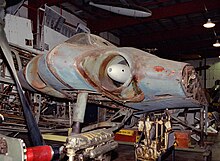
- H.IX V1
- First prototype, an unpowered glider, one built and flown (three-view drawing above).[2]
- H.IX V2
- First powered prototype, one built and flown with twin Junkers Jumo 004B engines.[2]
- Ho 229 V3
- Revised air intakes, engines moved forward to correct longitudinal imbalance. Its nearly completed airframe was captured in production, with two Junkers Jumo 004B jet engines installed in the airframe.
- Ho 229 V4
- Planned two-seat all-weather fighter, in construction at Friedrichroda, but not much more than the center-section's tubular framework completed.[2]
- Ho 229 V5
- Planned two-seat all-weather fighter, in construction at Friedrichroda, but not much more than the center-section's tubular framework completed.[2]
- Ho 229 V6
- Projected definitive single-seat fighter version with different cannon, mock-up in production at Ilmenau.
- H.IXb (also designated V6 and V7 by the Hortens)
- Projected two-seat trainer or night-fighter; not built.[2]
- Ho 229 A-0
- Projected expedited production version based on Ho 229 V6; not built.
Specifications (Horten Ho 229A (V3))
From manufacturer's estimates—three-view drawing at top of page shows the H.IX V1 glider prototype.
Data from The Great Book of Fighters[11]
General characteristics- Crew: 1
- Length: 7.47 m (24 ft 6 in)
- Wingspan: 16.76 m (55 ft 0 in)
- Height: 2.81 m (9 ft 2 in)
- Wing area: 50.20 m² (540.35 ft²)
- Empty weight: 4,600 kg (10,141 lb)
- Loaded weight: 6,912 kg (15,238 lb)
- Max. takeoff weight: 8,100 kg (17,857 lb)
- Powerplant: 2 × Junkers Jumo 004B turbojet, 8.7 kN (1,956 lbf) each
- Maximum speed: 977 km/h (607 mph) at 12,000 metres (39,000 ft)
- Service ceiling: 16,000 m (52,000 ft)
- Rate of climb: 22 m/s (4,330 ft/min)
- Wing loading: 137.7 kg/m² (28.2 lb/ft²)
- Thrust/weight: 0.26
- Guns: 4 × 30 mm MK 108 cannon
- Rockets: R4M rockets
- Bombs: 2 × 500 kilograms (1,100 lb) bombs


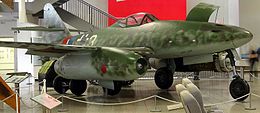
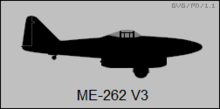
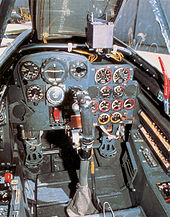
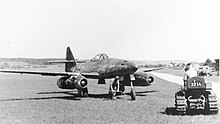

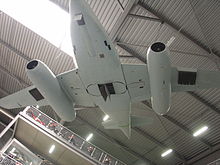


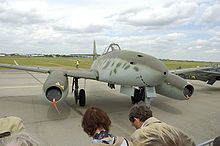
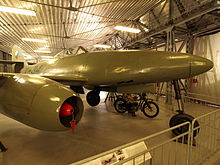
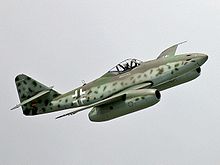



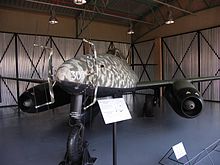



















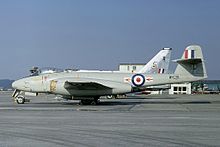









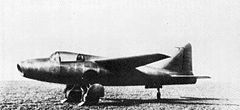




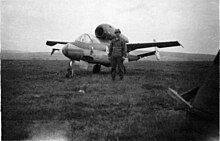




No comments:
Post a Comment